 | –≠–ª–µ–∫—Ç—Ä–æ–Ω–Ω—ã–π –∫–æ–º–ø–æ–Ω–µ–Ω—Ç: W78E354 | –°–∫–∞—á–∞—Ç—å:  PDF PDF  ZIP ZIP |

W78E354
MONITOR MICROCONTROLLER
Publication Release Date: April 1997
- 1 -
Revision A1
GENERAL DESCRIPTION
The W78E354 is a stand-alone high-performance microcontroller ASIC specially designed for use in
monitor control applications. Using the Winbond 0.8
µ
DPDM process, the W78E354 integrates an
embedded 8031 microcontroller core, 16K bytes of Flash cell, 512 bytes of RAM and a number of
dedicated hardware functions. These hardware functions include a 6-bit A/D converter, two/fourteen
12/8-bit PWM static DACs, one/three 12/8-bit PWM dynamic DACs, a sync processor, one DDC port,
a watchdog timer and other custom glue logic. Additional special function registers are incorporated to
control the on-chip peripheral hardware.
The chip is used to control the interface signals of other devices in the monitor and to process the
video sync signals. Because of high integration and the incorporation of Flash cell for program
memory, the device offers the user the competitive advantages of low cost and reduced development
time.
FEATURES
∑
80C31 MCU core included
∑
16K bytes Flash OTP memory for program storage
∑
Total 512 bytes of on-chip data RAM:
256 bytes accessed as in the 80C32, 256 bytes accessed as external data memory via "MOVX
@Ri".
∑
One SPI/RS232 port (a serial port of 8051 standard)
∑
One external interrupt input
∑
Two timers/counters
∑
PWM DACs:
-
Two 12-bit PWM/BRM Static DACs
-
Fourteen 8-bit PWM Static DACs
-
One 12-bit PWM/BRM Dynamic DAC
-
Three 8-bit PWM Dynamic DACs
∑
One 6-bit ADC with 4 multiplexed analog inputs
∑
Sync Processor:
-
Horizontal & Vertical Polarity Detector
-
Sync Separator for composite sync
-
Horizontal & Vertical Frequency Counter
-
Programmable dummy frequency generator
-
Programmable H-clamp pulse output
-
SOA output (hardware H frequency change detection)
∑
One DDC port (master/slave mode I
2
C with two slave address reg., support DC1/DDC2B/DDC2B+)
∑
One 8-bit Auto-reload timer for software time base

W78E354
- 2 -
∑
Watchdog Timer
∑
Two 15 mA output pins for driving LEDs
∑
Power down reset
∑
Clock: DC to 20 MHz
∑
Packaged in 68-pin PLCC, 48-pin DIP and 40-pin DIP
PIN CONFIGURATIONS
6
7
6
8
6
6
6
5
6
4
6
3
6
2
6
1
3 2 1
4
9 8 7 6 5
10
11
12
13
14
15
16
17
18
19
20
21
22
23
24
25
26
44
45
46
47
48
49
50
51
52
53
54
55
56
57
58
59
60
2
7
2
8
2
9
3
0
3
1
3
2
3
3
3
4
3
5
3
6
3
7
3
8
3
9
4
0
4
1
4
2
4
3
P
2
.
4
/
S
D
A
C
1
0
P
4
.
5
P
2
.
5
/
S
D
A
C
1
1
S
D
A
C
6
S
D
A
C
5
P
4
.
6
S
D
A
C
7
S
D
A
C
8
S
D
A
C
9
P
3
.
7
V
D
D
S
D
A
C
4
S
D
A
C
3
S
D
A
C
2
P
4
.
4
P
3
.
3
S
D
A
C
1
SDAC0
P4.3
DDAC0
VPP
P4.1
P4.0
P1.0
VDD
P1.4/HCLAMP
P1.3/DSDA
P1.1
P1.2/DSCL
P1.5/SOA
P4.2
BDDAC
DDAC2
DDAC1
P2.2
P3.4/T0
P2.3/STP
P3.5/T1
P2.7/SDAC13
P2.6/SDAC12
SDAC11
SDAC10
OSCIN
OSCOUT
P2.0
VSS
P2.1
SDAC12
SDAC13
VIN
HIN
A
D
C
0
V
O
U
T
H
O
U
T
V
S
S
V
A
A
P
3
.
1
/
T
X
D
P
3
.
2
/
I
N
T
0
V
S
S
A
P
3
.
0
/
R
X
D
B
S
D
A
C
0
P
3
.
6
R
E
S
E
T
B
S
D
A
C
1
A
D
C
1
A
D
C
2
/
P
1
.
6
A
D
C
3
/
P
1
.
7
T
e
s
t
C
L
K
W78E354P
(PLCC-68)
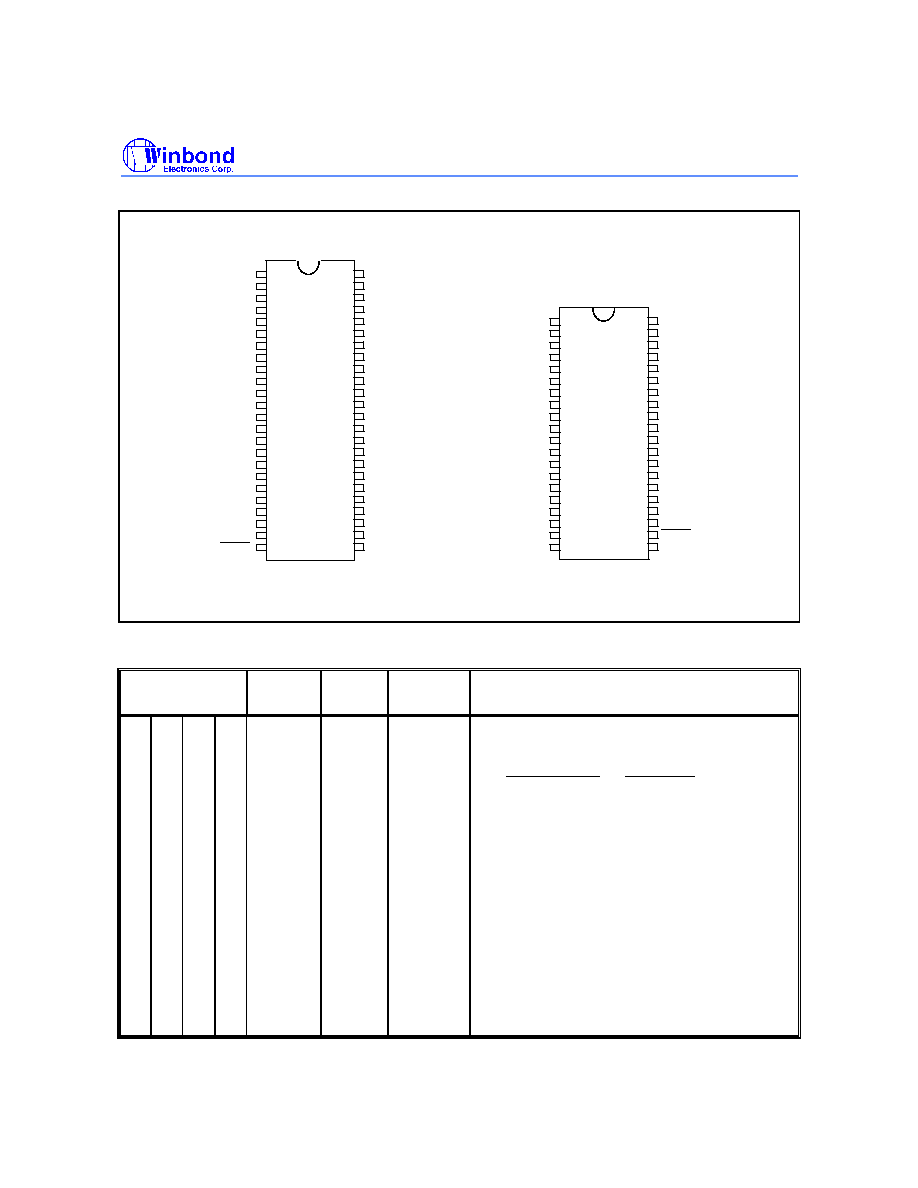
W78E354
Publication Release Date: April 1997
- 3 -
Revision A1
Pin Cinfigurations, continued
1
2
3
4
5
6
7
8
9
10
11
12
13
14
15
16
17
18
19
20
21
22
23
24
48
47
46
45
44
43
42
41
40
39
38
37
36
35
34
33
32
31
30
29
28
27
26
25
P1.4/HCLAMP
P1.3/DSDA
VSSA
V
TestCLK
P1.5/SOA
V
ADC0
VAA
P1.2/DSCL
P1.0
P1.1
BDDAC
SDAC4
SDAC3
SDAC2
SDAC1
SDAC0
DDAC2
DDAC1
DDAC0
P3.3
P3.6
P3.2/INT0
P2.4/SDAC10
P2.5/SDAC11
SDAC6
SDAC5
P3.4/T0
P2.6/SDAC12
P3.0/RXD
P2.7/SDAC13
SDAC7
P3.1/TXD
P3.5/T1
OSCOUT
OSCIN
VSS
P2.0
P2.2
P2.1
P2.3/STP
HIN
VIN
HOUT
VOUT
BSDAC0
RESET
W78E354E
(DIP-48)
1
2
3
4
5
6
7
8
9
10
11
12
13
14
15
16
17
18
19
20
40
39
38
37
36
35
34
33
32
31
30
29
28
27
26
25
24
23
22
21
BDDAC
V
SDAC4
SDAC3
SDAC2
SDAC1
SDAC0
P1.4/HCLAMP
P1.3/DSDA
P1.5/SOA
V
P1.2/DSCL
P1.0
P1.1
DDAC0
P3.1/TXD
TestCLK
ADC0
P3.2/INT0
RESET
W78E354
(DIP-40)
DD
PP
P2.4/SDAC10
P2.5/SDAC11
SDAC6
SDAC5
SDAC7
P2.6/SDAC12
P2.7/SDAC13
OSCOUT
OSCIN
V
P2.0
P2.2
P2.1
P2.3/STP
HIN
VIN
HOUT
VOUT
BSDAC0
P3.0/RXD
SS
PP
DD
PIN DESCRIPTION
PIN NO.
68P 64P 48P 40P
PIN
NAME
I/O
TYPE
TEST
NAME
FUNCTIONAL DESCRIPTION
60
62
63
65
66
3
4
5
6
7
10
11
19
20
57
59
60
61
62
1
2
3
4
5
8
9
17
18
42
44
45
46
47
1
2
3
-
-
-
-
-
-
35
36
37
38
39
1
2
3
-
-
-
-
-
-
SDAC0
SDAC1
SDAC2
SDAC3
SDAC4
SDAC5
SDAC6
SDAC7
SDAC8
SDAC9
SDAC10
SDAC11
SDAC12
SDAC13
I/O
O/P
A0
A1
A2
A3
A4
A5
A6
A7
-
-
-
-
-
-
8-bit PWM static DAC output.
Sink/Source current 4 mA/-4 mA.
With
slew rate control
and
output delay
:
1. Delay about 5 nS:
SDAC2, 5, 8, 11.
2. Delay about 10 nS:
SDAC0, 3, 6, 9, 12.
3. Without delay: the others.
---------------------------------------------------------
* In the Flash/RAM-test mode
(when the chip is in reset state):
SDAC0
-
7: A0
-
A7 inputs.
* In the functional test mode
(CPU executes out of ext. program memory):
SDAC0
-
7: A0
-
A7 outputs.
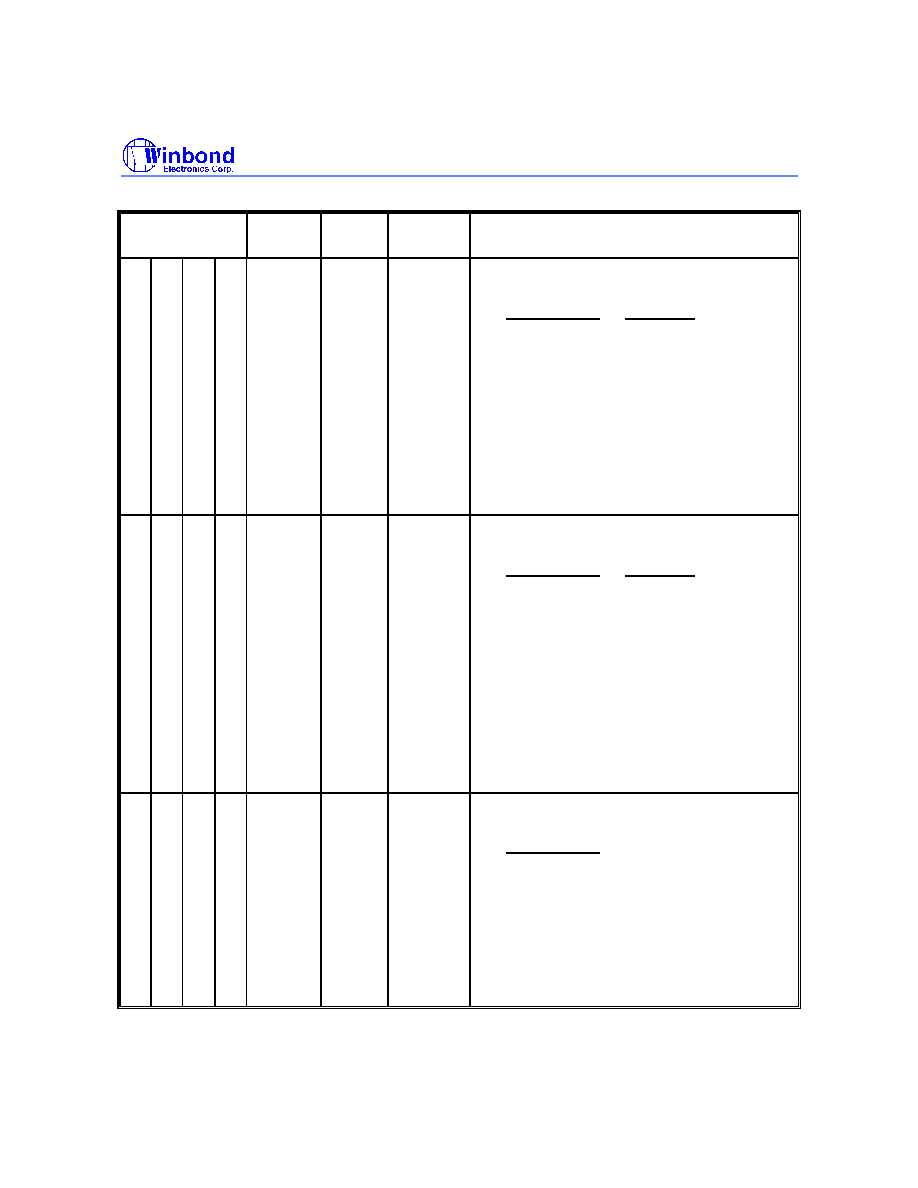
W78E354
- 4 -
Pin Description, continued
PIN NO.
68P 64P 48P 40P
PIN
NAME
I/O
TYPE
TEST
NAME
FUNCTIONAL DESCRIPTION
29
30
27
28
21
-
19
-
BSDAC0
BSDAC1
I/O
O/P
A8
-
12-bit PWM/BRM static DAC output.
Sink/Source current 8 mA/-8 mA.
With
slew rate control
and
output delay
:
1. Delay about 5ns: BSDAC1
2. Without delay: BSDAC0.
---------------------------------------------------------
* In the Flash/RAM-test mode
(when the chip is in reset state):
BSDAC0: A8 input.
* In the functional test mode
(CPU executes out of ext. program memory):
BSDAC0: A8 output.
56
57
58
53
54
55
38
39
40
33
-
-
DDAC0
DDAC1
DDAC2
I/O
O/P
A9
-
-
8-bit PWM dynamic DAC output.
Sink/Source current 8 mA/-8 mA.
With
slew rate control
and
output delay
:
1. Delay about 5 nS: DDAC1.
2. Delay about 10 nS: DDAC2.
3. Without delay: DDAC0.
---------------------------------------------------------
* In the Flash/RAM-test mode
(when the chip is in reset state):
DDAC0: A9 input.
* In the functional test mode
(CPU executes out of ext. program memory):
DDAC0: A9 output.
59
56
41
34
BDDAC
I/O
A10
12-bit PWM/BRM dynamic DAC output.
Sink/Source current 8mA/-8mA.
With
slew rate control
.
---------------------------------------------------------
* In the Flash/RAM-test mode
(when the chip is in reset state):
BDDAC: A10 input.
* In the functional test mode
(CPU executes out of ext. program memory):
BDDAC: A10 output.

W78E354
Publication Release Date: April 1997
- 5 -
Revision A1
Pin Description, continued
PIN NO.
68P 64P 48P 40P
PIN
NAME
I/O
TYPE
TEST
NAME
FUNCTIONAL DESCRIPTION
36
37
39
40
34
35
37
38
26
-
-
-
23
-
-
-
ADC0
ADC1
ADC2
(P1.6)
ADC3
(P1.7)
I/P
-
-
-
-
Analog signal input channel to ADC.
Alternate function:
ADC2: P1.6 input (input only).
ADC3: P1.7 input (input only).
46
47
44
45
31
32
26
27
P1.0
P1.1
I/O
A13
A14
General purpose I/O.
Open-drain, Sink current 2mA.
Schmitt trigger I/P.
No PMOS ESD cell.
V
IH
= 3.0V (min), V
IL
= 1.5V (max)
---------------------------------------------------------
* In the Flash/RAM-test mode
(when the chip is in reset state):
P1.0 and P1.1: A13 and A14 inputs.
* In the functional test mode
(CPU executes out of ext. program memory):
P1.0 and P1.1:
do not output A13 and A14, but function in
their normal operational state.
48
49
46
47
33
34
28
29
P1.2
(DSCL)
P1.3
(DSDA)
I/O
A13CTRL
A14CTRL
General purpose I/O.
Open-drain, Sink current 6mA.
Schmitt trigger I/P.
No PMOS ESD cell.
V
IH
= 3.0V (min), V
IL
= 1.5V (max)
Alternate function:
P1.2: DDC port serial clock DSCL.
P1.3: DDC port serial data DSDA.
---------------------------------------------------------
* In the Flash/RAM-test mode
(when the chip is in reset state):
P1.2: A13CTRL input.
P1.3: A14CTRL input.

W78E354
- 6 -
Pin Description, continued
PIN NO.
68P 64P 48P 40P
PIN
NAME
I/O
TYPE
TEST
NAME
FUNCTIONAL DESCRIPTION
50
48
35
30
P1.4
(HCLAMP)
I/O
A9CTRL
General purpose I/O.
Sink/Source current 4 mA/-100
µ
A.
Alternate function:
P1.4: HCLAMP (H-clamp pulse) output.
While outputing special function, P1.4's Sink/Source
current is 4 mA/-4 mA
.
---------------------------------------------------------
* In the Flash/RAM-test mode
(when the chip is in reset state):
P1.4: A9CTRL input.
51
49
36
31
P1.5
(SOA)
I/O
A11
General purpose O/P.
Sink/Source current 4 mA/-4 mA.
Alternate function:
P1.5: SOA (Safe Operation Area) outpout.
---------------------------------------------------------
* In the Flash/RAM-test mode
(when the chip is in reset state):
P1.5: A11 input.
* In the functional test mode
(CPU executes out of ext. program memory):
P1.5:
doesn't output A11, but functions as
its normal operation.
17
18
15
16
11
12
11
12
P2.0
P2.1
I/O
D0
D1
General purpose I/O.
Sink/Source current 15mA/-100
µ
A.
With
slew rate control
.
---------------------------------------------------------
* In the Flash/RAM-test mode
(when the chip is in reset state):
P2.0
-
P2.1: D0
-
D1 data inputs/outputs.
* In the functional test mode
(CPU executes out of ext. program memory):
P2.0
-
P2.1: D0
-
D1 program inputs.

W78E354
Publication Release Date: April 1997
- 7 -
Revision A1
Pin Description, continued
PIN NO.
68P 64P 48P 40P
PIN
NAME
I/O
TYPE
TEST
NAME
FUNCTIONAL DESCRIPTION
21
22
8
9
12
13
19
20
6
7
10
11
13
14
4
5
6
7
13
14
4
5
6
7
P2.2
P2.3
(STP)
P2.4
(SDAC10)
P2.5
(SDAC11)
P2.6
(SDAC12)
P2.7
(SDAC13)
I/O
D2
D3
D4
D5
D6
D7
General purpose I/O.
Sink/Source current 4 mA/-100
µ
A.
Alternate function:
P2.3: STP (Self-Test Pattern) output.
P2.4
-
P2.7: SDAC10
-
13 outputs.
While outputing special function, P2.3
-
P2.7's
Sink/Source current is 4mA/-4mA
.
---------------------------------------------------------
* In the Flash/RAM-test mode
(when the chip is in reset state):
P2.2
-
P2.7: D2
-
D7 data inputs/outputs.
* In the functional test mode
(CPU executes out of ext. program memory):
P2.2
-
P2.7: D2
-
D7 program inputs.
31
32
42
61
23
24
43
67
29
30
40
58
21
22
41
63
22
23
29
43
15
16
30
-
20
21
25
-
-
-
-
-
P3.0
(RXD)
P3.1
(TXD)
P3.2
(INT0)
P3.3
P3.4 (T0)
P3.5 (T1)
P3.6
P3.7
I/O
-
-
A12
(PSEN)
-
-
-
-
-
General purpose I/O.
Sink/Source current 2 mA/-100
µ
A.
Alternate function:
P3.0: 8051 serial input port.
P3.1: 8051 serial output port.
P3.2: External interrupt input.
P3.4 and P3.5: Timer/counter 0 and 1 external inputs.
---------------------------------------------------------
* In the Flash/RAM-test mode
(when the chip is in reset state):
P3.2: A12 input.
* In the functional test mode
(CPU executes out of ext. program memory):
P3.2:
PSEN
output (the read strobe to
external program memory) instead of A12.
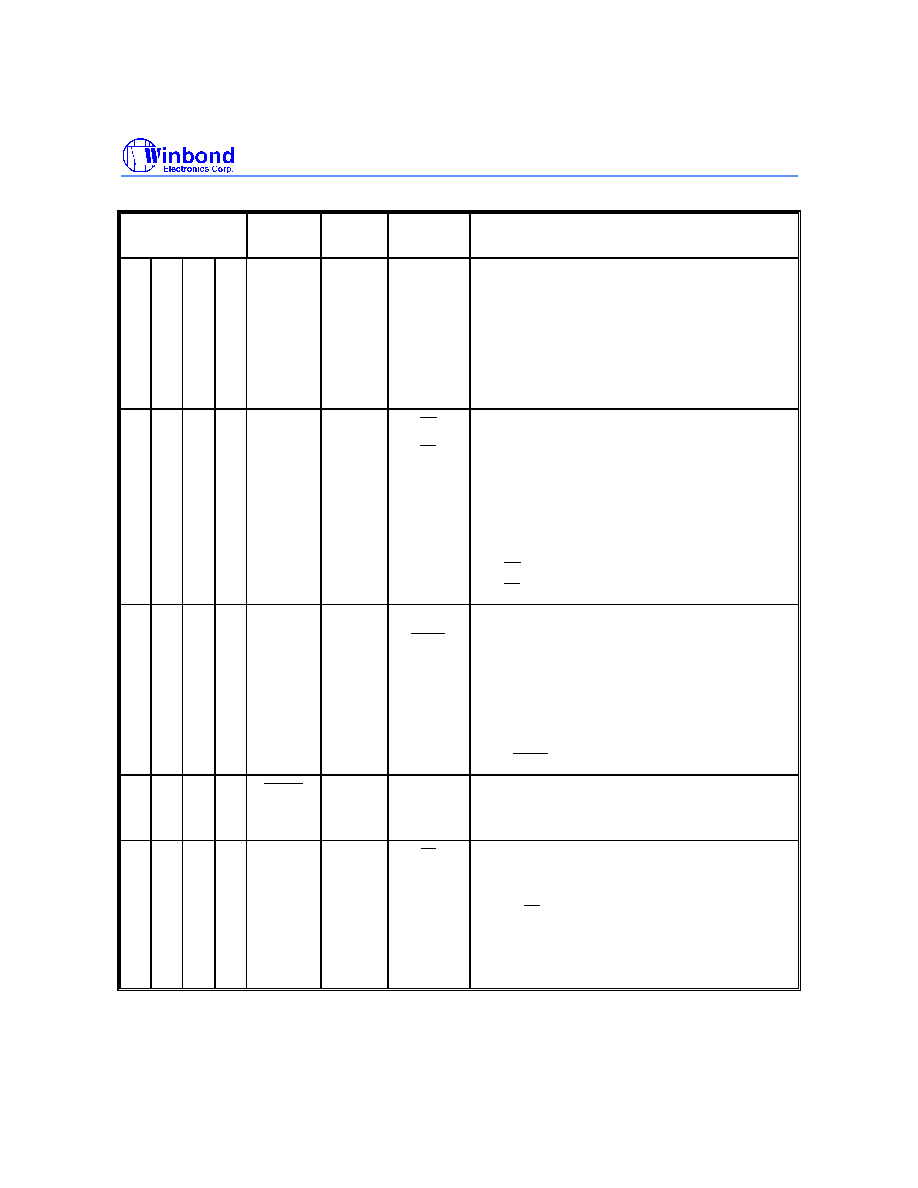
W78E354
- 8 -
Pin Description, continued
PIN NO.
68P 64P 48P 40P
PIN
NAME
I/O
TYPE
TEST
NAME
FUNCTIONAL DESCRIPTION
44
45
53
55
64
1
2
42
43
51
-
-
-
-
-
-
-
-
-
-
-
-
-
-
-
-
-
-
P4.0
P4.1
P4.2
P4.3
P4.4
P4.5
P4.6
O/P
-
-
-
-
-
-
-
Output port (Latch output).
Sink/Source current 2 mA/-2 mA.
25
26
23
24
17
18
15
16
H
IN
V
IN
I/P
OE
CE
H
IN
: Hsync/Composite sync input.
V
IN
: Vsync input.
Schmitt trigger I/P.
With Internal high value pull-down (about 200 K
).
No PMOS ESD diode.
---------------------------------------------------------
* In the Flash/RAM-test mode
(when the chip is in reset state):
H
IN
: OE input.
V
IN
: CE input.
27
28
25
26
19
20
17
18
H
OUT
V
OUT
I/O
OECTRL
PROG
H
OUT
: Hsync output.
V
OUT
: Vsync output with internal weak pull-up (above 200
K
).
Sink/Source current 4 mA/-4 mA.
---------------------------------------------------------
* In the Flash/RAM-test mode
(when the chip is in reset state):
H
OUT
: OECTRL input.
V
OUT
: PROG input.
33
31
24
22
RESET
I/P
-
Reset the controller (active low).
Schmitt trigger I/P.
With internal pull-up (about 30 K
).
41
39
28
24
TestCLK
I/P
EA
Clock input while in internal (glue logic's) function test.
With internal pull-up (about 30 K
).
---------------------------------------------------------
* If the EA (TestCLK) pin is pulled low when the chip is
being reset, and remains low for at least 24 clock periods
after the reset, the CPU will execute from the external
program memory regardless of the PC value. i.e., the CPU is
forced to enter the
functional test mode
.

W78E354
Publication Release Date: April 1997
- 9 -
Revision A1
Pin Description, continued
PIN NO.
68P 64P 48P 40P
PIN
NAME
I/O
TYPE
TEST
NAME
FUNCTIONAL DESCRIPTION
14
15
12
13
8
9
8
9
OSC
OUT
OSC
IN
O/P
I/P
-
-
Output from the inverting oscillator amplifier.
Input to the inverting oscillator amplifier.
Freq.: 16 MHz to 24 MHz.
54
52
37
32
V
PP
-
V
PP
In the Test/Flash mode, this pin is the power supply input for
the Flash cell.
68
64
48
40
V
DD
-
-
Positive digital power supply, +5V.
16
14
10
10
V
SS
-
-
Digital ground.
52
50
-
-
V
DD
-
-
Positive digital power supply, +5V.
Internally connected to the other power source.
34
32
-
-
V
SS
-
-
Digital ground.
Internally connected to the other power source.
38
36
27
-
VAA
-
-
Positive analog power supply, +5V.
35
33
25
-
VSSA
-
-
Analog ground.

W78E354
- 10 -
BLOCK DIAGRAM
W78E354
V
AA,
V
SSA
8031 MCU core
with 256B
Scratchpad RAM
Power
Source
Supervisor
Reset
Circuit
WDT
OSC/Timing
Generator
RESET
T1 (P3.5)
T0 (P3.4)
TXD (P3.1)
RXD (P3.0)
Sync
Processor
Vpp
16KB
Flash ROM
256B
Data Memory
Interrupt
Processor
SDAC
DDAC
INT0 (P3.2)
SDAC0~13
BSDAC0~1
DDAC0~2
BDDAC
ADC
ADC0~3
V
V
SS
DD
Srial Port
Timer 0
Timer1
DDC
I/O Port
Autoload
Timer
DSCL (P1.2)
DSDA (P1.3)
Port 1, 2, 3
(except P1.5)
P1.5, Port 4
OSCIN
OSCOUT
HIN, VIN
HOUT, VOUT
SOA (P1.5)
HCLAMP (P1.4)

W78E354
Publication Release Date: April 1997
- 11 -
Revision A1
FUNCTIONAL DESCRIPTION
A. 80C31 Core
The W78E354's 80C31 (CMOS MCU) core architecture consists of a CPU surrounded by various
Special Function Registers or SFRs. Some of these SFRs are standard 80C31 registers while others
are new additions, cf. Table 1. The device includes three general purpose I/O ports (P1, P2 and P3),
one output-only port (P4), 256 bytes of scratchpad RAM, two timer/counters (Timer0 and Timer1) and
one 8051 standard serial port. The processor supports 109 different instructions (without "MOVX
A,@DPTR" and "MOVX @DPTR,A") all of which are compatible with those of the MCS-51 family.
One distinguishing feature of the device architecture is the SFR address space into which all the
registers, peripherals and scratchpad RAM are mapped. Many of the instructions operate on an SFR
address rather than a specific register, greatly increasing the power of the instruction set.
The core controller has been designed around a state machine rather than utilizing a microcode
approach, a design methodology which offers several advantages. The first of these is that faster
circuits can be produced due to the fact that flip-flops are inherently faster than ROMs. Secondly, a
ROM-free approach allows the design to be directly utilized in ASIC gate array implementations, an
important factor for cost reductions. Finally, an entire digital logic approach provides better supply
noise immunity in most applications.
Table 1. W78E354's Special Function Registers (SFRs)
F8
FF
F0
+ B
F7
E8
EF
E0
+ ACC
E7
D8
+ S1CON
S1STA
S1DAT
S1ADR
DF
D0
+ PSW
D7
C8
+
CONTREG4
CF
C0
C7
B8
+ IP
SBRM0
SBRM1
PORT4
SOAREG
SOACLR
BF
B0
+ P3
ADC
INTVECT
STATUS
HFCOUNTL
HFCOUNTH
VFCOUNTL
VFCOUNTH
B7
A8
+ IE
SDAC7
SDAC8
SDAC9
SDAC10
SDAC11
SDAC12
SDAC13
AF
A0
+ P2
SDAC0
SDAC1
SDAC2
SDAC3
SDAC4
SDAC5
SDAC6
A7
98
+ SCON
SBUF
BSDAC0
BSDAC1
WDTCLR
DDAC0
DDAC1
DDAC2
9F
90
+ P1
AUTOLOAD
DHREG
DVREG
DDC1
INTMSK
BDDAC
DBRM
97
88
+ TCON
TMOD
TL0
TL1
TH0
TH1
PARAL
PARAH
8F
80
+
CONTREG1
SP
DPL
DPH
CONTREG5
CONTREG2
CONTREG3
PCON
87
Notes:
1. The SFRs with a "+" are both byte- and bit-addressable.
2. The registers in the shaded region are new additions to the 80C31 SFRs.
A.1 Address Space (cf. Figure 1)
The W78E354 CPU operates out of three separate address spaces:
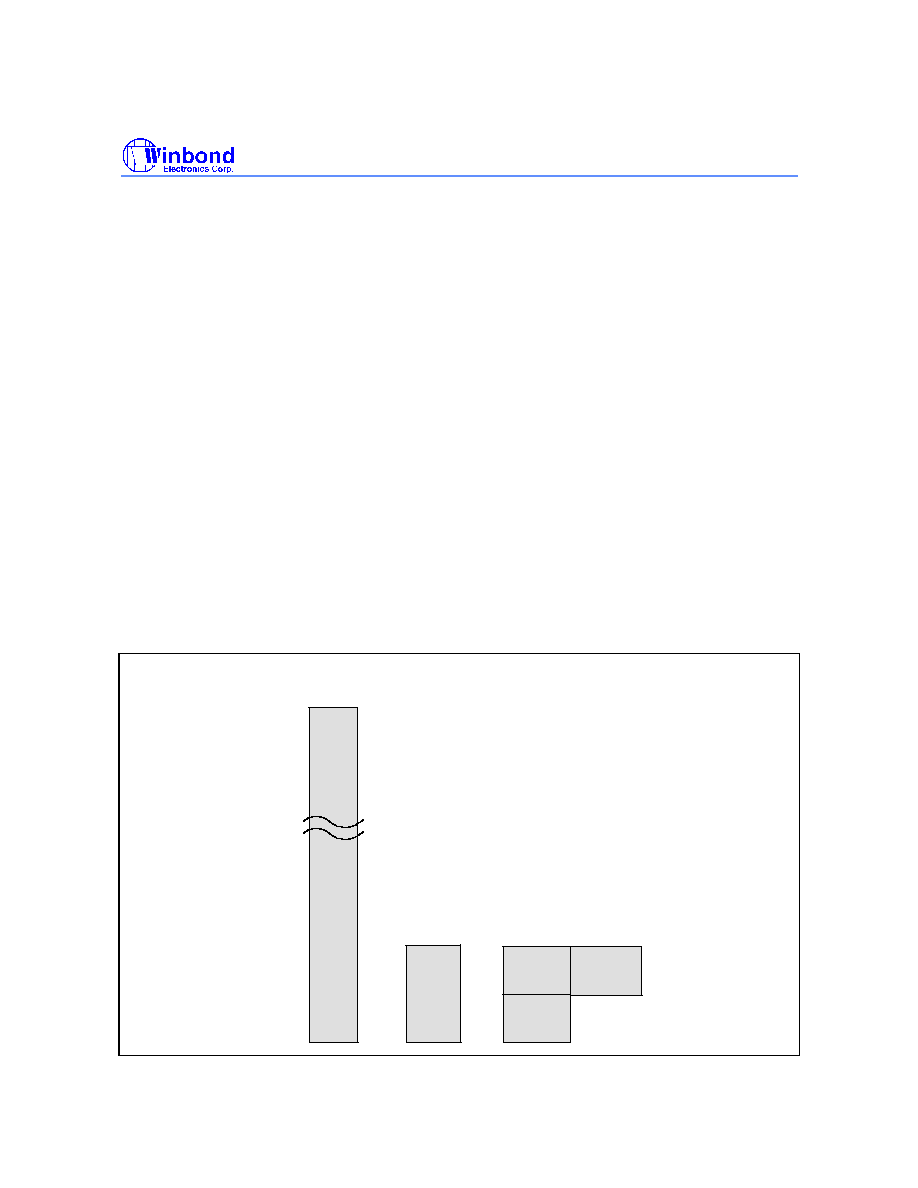
W78E354
- 12 -
1. The first of these is the internal program space (internal Flash memory) with 16K byte size
(0000H
-
3FFFH). The program space can be accessed by both opcode fetches and the
"MOVC"
instructions.
2. The second is referred to as the data memory space and has a size of 256 bytes (0000H
-
00FFH).
The data memory is integrated within the chip rather than being outside as in the case of the
standard 8031. The "inside" data memory space is accessed by the "MOVX @Ri" instruction.
3. The third address space has 256 locations while it is used by 384 bytes (256 bytes of RAM and 128
bytes of SFRs).
∑
The lower 128 locations of this address space (00H
-
7FH) are for the lower 128 bytes of scratchpad
RAM. Any of these 128 bytes may be used by a programmer but some of them have special uses.
The lowest 32 bytes are organized to four 8-byte register banks. The bank select bits (RS0 and RS1
in the PSW register) selects one of these four banks which is to be used currently as an operand in
the instruction set. Registers 0 to 7 in the bank are referenced by the register direct opcodes.
Registers 0 and 1 may also contain an address that is referenced by the register indirect opcodes.
∑
The higher 128 locations of this address space (80H
-
FFH) are shared by the higher 128 bytes of
scratchpad RAM and the Special Function Registers (SFRs). The SFRs are accessed only by "direct"
addressing while the higher 128 bytes of scrachpad RAM are accessed only by "indirect" addressing.
The higher 128 bytes of scratchpad data RAM are also available for stack space.
Address spaces 20H to 2FH are bit-addressable and can be used by the Boolean Variable
Manipulation instructions. For example, bit 0 of address 20H has a Boolean address 00H, and bit 7 of
address 2FH has a Boolean address 7FH. The higher Boolean addresses (80H
-
FFH) are mapped
into the SFR address space. To determine a Boolean address in some bit-addressable SFR, the
higher 5 bits of the SFR's address can be combined with the 3 lower bits that specify the desired bit in
the SFR.
0000H
3FFFH
00H
FFH
00H
On-Chip
Program
Memory
On-Chip
Data
Memory
FFH
7FH
80H
(Direct Addressing)
(Direct/Indirect
Addressing)
SFR
Scratchpad
RAM
(Indirect Addressing)
Scratchpad
RAM
(MOVX @Ri)
Figure1. Addres Space

W78E354
Publication Release Date: April 1997
- 13 -
Revision A1
A.2 The Modified 80C31 SFRs
1. Timer/Counter Control Register: TCON
BIT
NAME
FUNCTION
TCON.7
TF1
Timer 1 overflow flag.
Set by hardware on timer/counter overflow. Cleared by hardware when the
processor vectors to the interrupt routine.
TCON.6
TR1
Timer 1 run control bit.
Set/cleared by software to turn the timer/counter on or off.
TCON.5
TF0
Timer 0 overflow flag.
Set by hardware on timer/counter overflow. Cleared by hardware when the
processor vectors to the interrupt routine.
TCON.4
TR0
Timer 0 run control bit.
Set/cleared by software to turn the timer/counter on or off.
TCON.3
-
(Reserved, not used by users.)
TCON.2
-
(Reserved)
TCON.1
IE0
Interrupt 0 edge flag.
Set by hardware when an external interrupt edge is detected. Cleared when
the interrupt is processed.
TCON.0
IT0
Interrupt 0 type control bit.
Set/cleared by software to specify falling edge/low level triggered external
interrupt.
2. Power Control Register: PCON
BIT
NAME
FUNCTION
7
SMOD
Double baud rate bit.
6
-
(Reserved)
5
-
(Reserved, not used by users.)
4
-
(Reserved for testing, not used by users.
Normally 0. If set, P2.4
-
P2.7 will output SDAC8-11 after reset (not power-
on reset).)
3
GF1
General-purpose flag bit.
2
GF0
General-purpose flag bit.
1
PD
Power-down mode bit.
0
IDL
Idle mode bit.

W78E354
- 14 -
3. Interrupt Enable Register: IE
BIT
NAME
FUNCTION
IE.7
EA
If EA = 0, no interrupt will be acknowledged (disable all interrupts).
If EA = 1, each interrupt source is individually enabled or disabled by setting or
clearing its enable bit.
IE.6
-
(Reserved)
IE.5
*1
Set/clear to enable/disable the DDC port's I
2
C interrupt.
IE.4
ES
Set/clear to enable/disable the serial port 0 interrupt.
IE.3
ET1
Set/clear to enable/disable the Timer 1 overflow interrupt.
IE.2
*1
Set/clear to enable/disable the *2 interrupt.
IE.1
ET0
Set/clear to enable/disable the Timer 0 overflow interrupt.
IE.0
EX0
Set/clear to enable/disable the external interrupt 0.
Notes:
*1: No name for ASSEMBLER, must be used via "IE.x".
*2 = (DSCLINT + ADCINT + TIMEOUT + SOAINT + VEVENT + PARAINT + DDC1INT).
4. Interrupt Priority Register: IP
BIT
NAME
FUNCTION
IP.7
-
(Reserved)
IP.6
-
(Reserved)
IP.5
*1
Define the DDC port's I
2
C interrupt priority level.
If IP.5 = 1, the priority level is higher.
IP.4
PS
Define the serial port interrupt priority level.
If PS = 1, the priority level is higher.
IP.3
PT1
Define the Timer 1 interrupt priority level.
If PT1 = 1, the priority level is higher.
IP.2
*1
Define the *2 priority level.
If IP.2 = 1, the priority level is higher.
IP.1
PT0
Define the Timer 0 interrupt priority level.
If PT0 = 1, the priority level is higher.
IP.0
PX0
Define the external interrupt 0 priority level.
If PX0 = 1, the priority level is higher.
Notes:
*1: No name for ASSEMBLER, must be used via "IP.x".
*2 = (DSCLINT + ADCINT + TIMEOUT + SOAINT + VEVENT + PARAINT + DDC1INT).
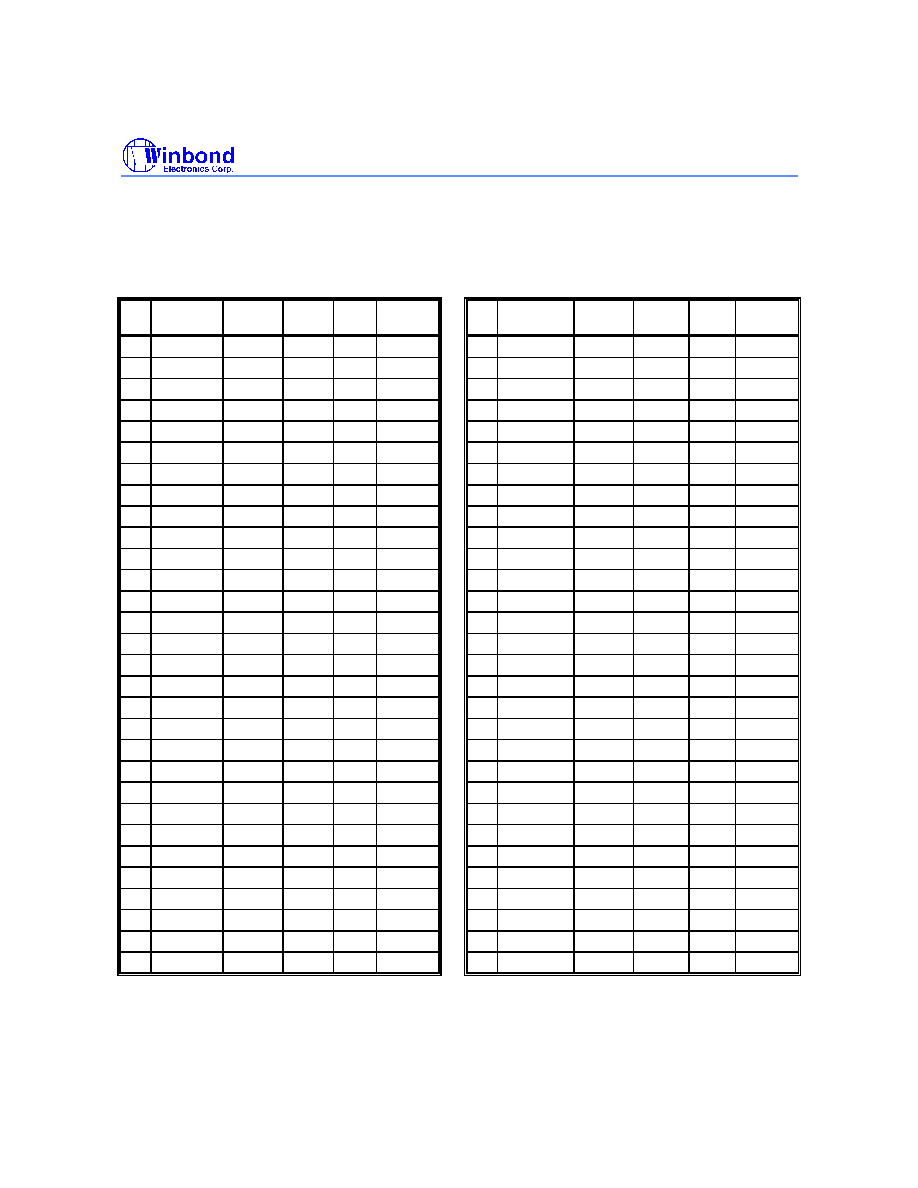
W78E354
Publication Release Date: April 1997
- 15 -
Revision A1
A.3 New Register Description
In addition to the 80C31 standard SFRs, the W78E354 has some newly added Special Function
Registers in the SFR address space as listed in Table 2.
Table 2. Newly Added Special Function Registers (SFRs)
REGISTER ADDRESS LENGTH R/W
TYPE
RESET
CONTENT
REGISTER ADDRESS LENGTH
R/W
TYPE
RESET
CONTENT
1
CONTREG1
80H
8
R/W
00H
31
VFCOUNTL
B6H
8
R
00H
2
CONTREG2
85H
8
W
00H
32
VFCOUNTH
B7H
8
R
00H
3
CONTREG3
86H
8
W
00H
33
DHREG
92H
4
W
00H
4
CONTREG4
C8H
8
R/W
00H
34
DVREG
93H
8
W
00H
5
CONTREG5
84H
8
R/W
00H
35
PARAL
8EH
8
W
00H
6
SDAC0
A1H
8
W
00H
36
PARAH
8FH
8
W
00H
7
SDAC1
A2H
8
W
00H
37
AUTOLOAD
91H
8
W
00H
8
SDAC2
A3H
8
W
00H
38
WDTCLR
9CH
-
W
-
9
SDAC3
A4H
8
W
00H
39
SOAREG
BCH
8
W
00H
10
SDAC4
A5H
8
W
00H
40
SOACLR
BDH
-
W
-
11
SDAC5
A6H
8
W
00H
41
INTMSK
95H
8
W
00H
12
SDAC6
A7H
8
W
00H
42
INTVECT
B2H
8
R/W
00H
13
SDAC7
A9H
8
W
00H
43
STATUS
B3H
4
R
00H
14
SDAC8
AAH
8
W
00H
44
ADC
B1H
8
R
80H
15
SDAC9
ABH
8
W
00H
45
PORT4
BBH
7
W
00H
16
SDAC10
ACH
8
W
00H
46
DDC1
94H
8
W
00H
17
SDAC11
ADH
8
W
00H
47
S1CON
D8H
8
R/W
00H
18
SDAC12
AEH
8
W
00H
48
S1STA
D9H
8
R
F8H
19
SDAC13
AFH
8
W
00H
49
S1DAT
DAH
8
R/W
00H
20
BSDAC0
9AH
8
W
00H
50
S1ADR
DBH
8
R/W
00H
21
SBRM0
B9H
4
W
00H
22
BSDAC1
9BH
8
W
00H
23
SBRM1
BAH
4
W
00H
24
DDAC0
9DH
8
W
00H
25
DDAC1
9EH
8
W
00H
26
DDAC2
9FH
8
W
00H
27
BDDAC
96H
8
W
00H
28
DBRM
97H
4
W
00H
29
HFCOUNTL
B4H
8
R
00H
30
HFCOUNTH
B5H
8
R
00H
Note: '-' means the SFR has no real hardware but an address.
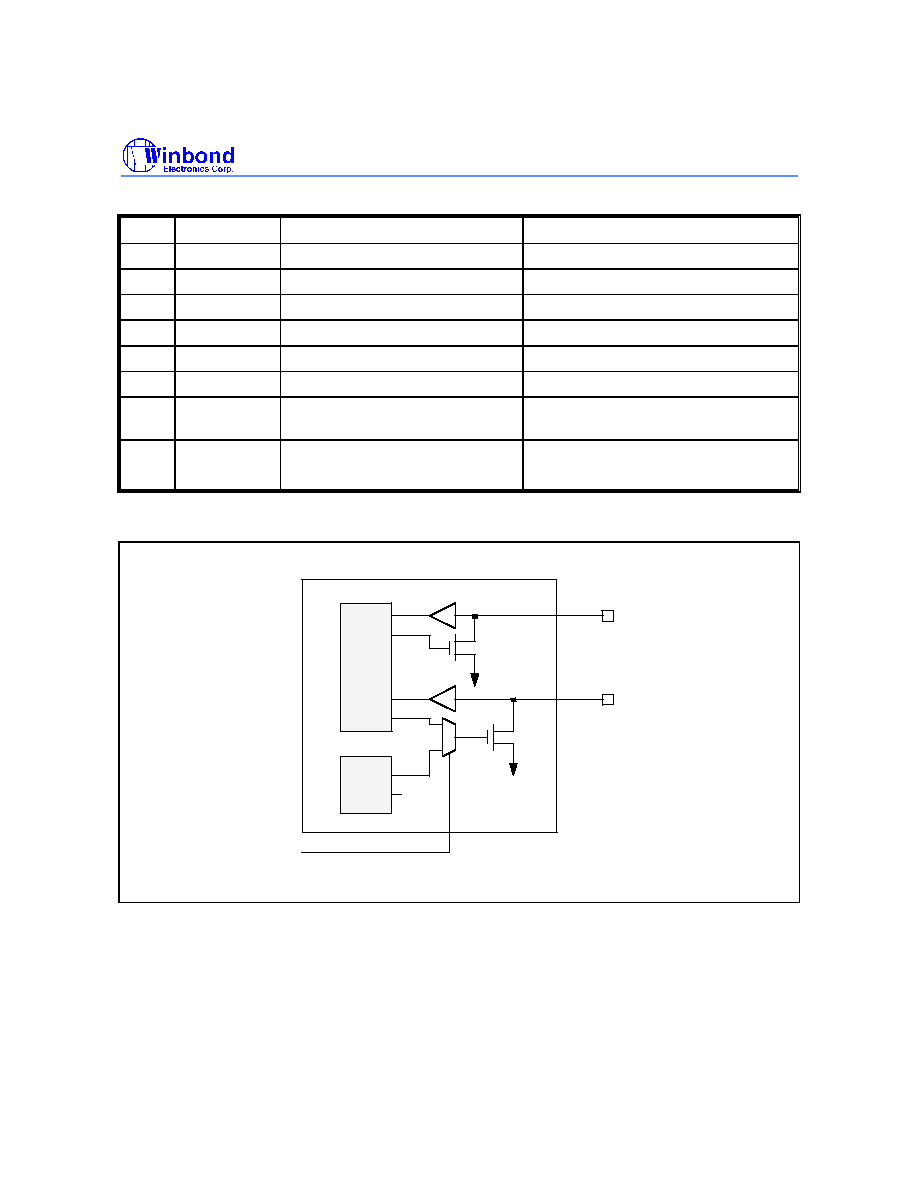
W78E354
- 16 -
*
CONTREG1
: Control register1, bit-addressable.
BIT
NAME
FUNCTION
NOTE
0
ADCS0
ADC channel Select bit 0
See Section E.10.
1
ADCS1
ADC channel Select bit 1
See Section E.10.
2
ENDDC1
Enable DDC1
See below.
3
HCES
H-Clamp Edge Select
See Section E.12.f.
4
HCWS0
H-Clamp Width Select bit 0
See Section E.12.f.
5
HCWS1
H-Clamp Width Select bit 1
See Section E.12.f.
6
DUMMYEN
Dummy signal Enable
See Section E.12. 'Sync Processor
Block Diagram' & E.12.e.
7
ADCSTRT
Start ADC conversion
0: Stop, 1: Start
See Section E.10.
DDC1
ENDDC1
DDC Port
P1.2/DSCL
P1.3/DSDA
I C
2
Support DDC2B/2B+
Support DDC1
IN
IN
OUT
OUT
OUT
SCL
SDA
SDA
SCL
0
1
from Vsync
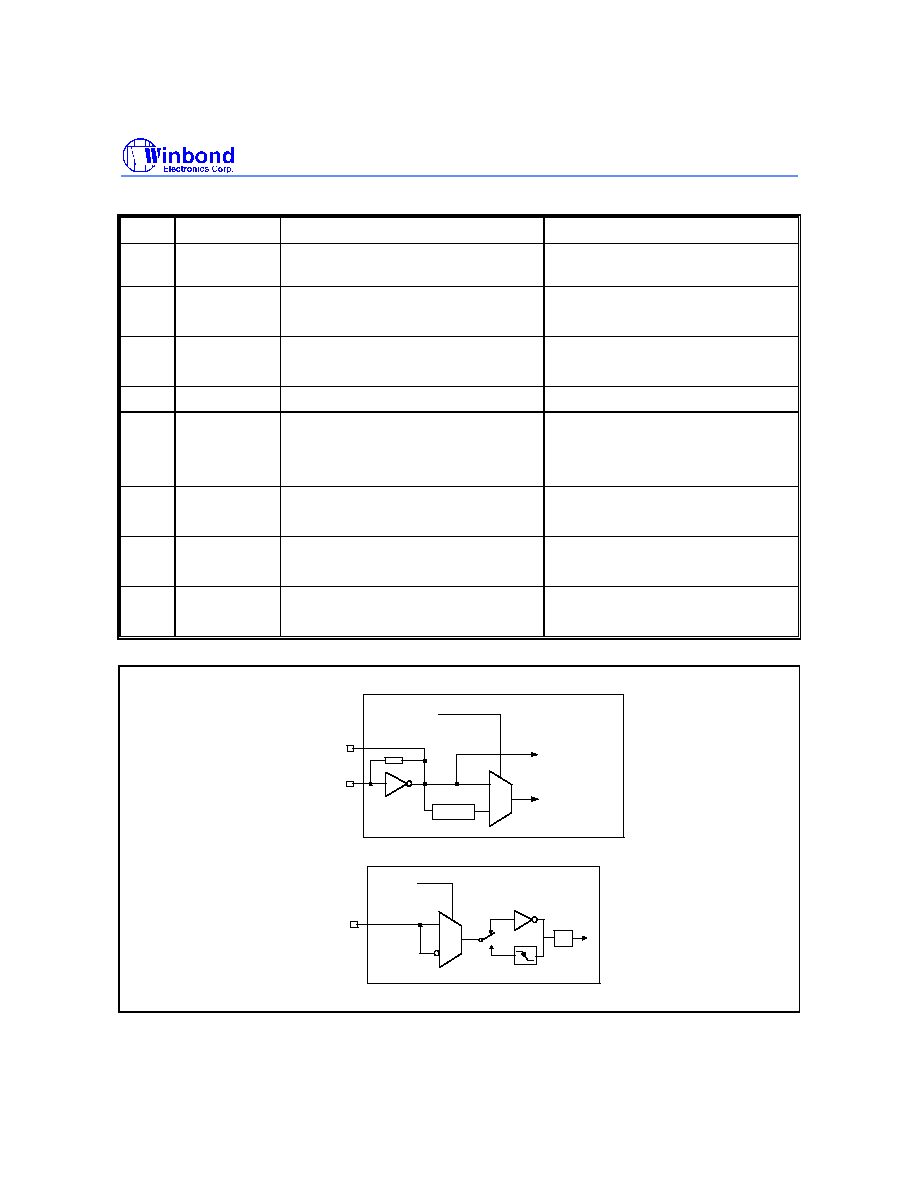
W78E354
Publication Release Date: April 1997
- 17 -
Revision A1
*
CONTREG2
: Control register2.
BIT
NAME
FUNCTION
NOTE
0
ENVS
ENable Vsync Separator
See Section E.12. 'Sync Processor
Block Diagram' & E.12.e.
1
HSPS
HSync Polarity Select
0: Positive, 1: Negative
See Section E.12. 'Sync Processor
Block Diagram'.
2
VSPS
VSync Polarity Select
0: Positive, 1: Negative
See Section E.12. 'Sync Processor
Block Diagram'.
3
OSCSEL
OSC or OSC/2 SELect
See below.
4
EINTES
External INT Edge Select
0: High-level/rising-edge triggered
1: Low-level/falling-edge triggered
See below.
5
ENM0
ENable SDAC0 Moire cancel function
0: Disable, 1:Enable
6
ENM1
ENable SDAC1 Moire cancel function
0: Disable, 1:Enable
7
VDISHC
Vsync DISable H-Clamp pulse
0: Enable, 1:Disable
See Section E.12. 'Sync Processor
Block Diagram'.
OSCOUT
OSCIN
0
1
OSCSEL
Divided by 2
To Sync processor
To CPU core
0
1
EINTES
IE0
IT0
0
1
INT0
(P3.2)

W78E354
- 18 -
*
CONTREG3
: Control register3.
BIT
NAME
FUNCTION
NOTE
0
P4SF
Port 4 Special Function
1
TSTMOD1
Function test mode1
2
TSTMOD2
Function test mode2
3
TSTMOD3
Function test mode3
4
TVSEP
Test VSEP signal
5
-
(Reserved for internal use.)
6
-
(Reserved for internal use.)
7
-
(Reserved for internal use.)
*CONTREG4
: Control register4, bit-addressable.
BIT
NAME
FUNCTION
NOTE
0
P24SF
Port 2.4 Special Function* (SDAC10)
See below.
1
P25SF
Port 2.5 Special Function* (SDAC11)
See below.
2
P26SF
Port 2.6 Special Function* (SDAC12)
See below.
3
P27SF
Port 2.7 Special Function* (SDAC13)
See below.
4
P14SF
Port 1.4 Special Function*
See below.
5
P15SF
Port 1.5 Special Function*
See below.
6
P23SF
Port 2.3 Special Function*
See below.
7
INVSTP
Invert Self-Test Pattern
*Note:In addition to setting PxySF, the port latch Pxy must have been cleared previously to enable the Pxy output special
functions.
0
1
P14SF
P1.4/HCLAMP
P1.4 latch
H-Clamp pulse
0
1
P15SF
P1.5/SOA
P1.5 latch
SOA output

W78E354
Publication Release Date: April 1997
- 19 -
Revision A1
0
1
P2mSF
P2.m/SDACn
P2.m latch
SDACn
4 10
5 11
6 12
7 13
0
1
P23SF
P2.3/STP
P2.3 latch
STP output
m n
*CONTREG5
: Control register5.
BIT
NAME
FUNCTION
NOTE
0
1
2
3
4
5
HDSEL
HCLAMP Source SELect
6
DPARAINT
Enable parabola with dummy Sync.
7
* STATUS
: Status register.
BIT
NAME
FUNCTION
0
HP
Hsync polarity. 0: Positive, 1: Negative.
1
VP
Vsync polarity. 0: Positive, 1: Negative.
2
NOH
Set by hardware if no Hsync.
3
NOV
Set by hardware if no Vsync.
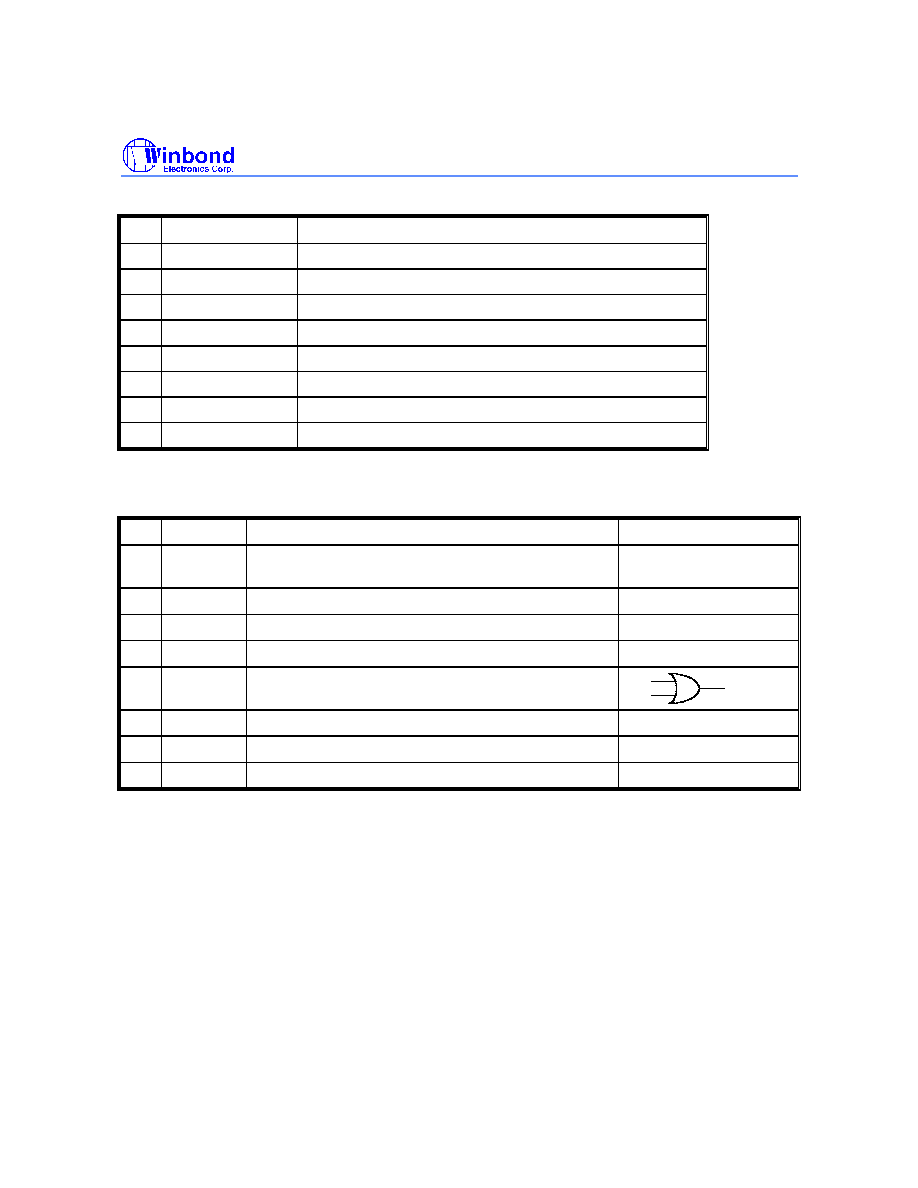
W78E354
- 20 -
* INTMSK
: Interrupt mask register.
BIT
NAME
FUNCTION
0
DSCLINTmsk
Set/clear to enable/disable DSCLINT interrupt.
1
ADCINTmsk
Set/clear to enable/disable ADCINT interrupt.
2
TIMEOUTmsk
Set/clear to enable/disable TIMEOUT interrupt.
3
SOAINTmsk
Set/clear to enable/disable SOAINT interrupt.
4
VEVENTmsk
Set/clear to enable/disable VEVENT interrupt.
5
PARAINTmsk
Set/clear to enable/disable PARAINT interrupt.
6
DDC1INTmsk
Set/clear to enable/disable DDC1INT interrupt.
7
Note: A '1' in any bit of the INTMSK register enables the corresponding interrupt flag in INTVECT to be set by hardware when
the interrupt source generates an interrupt.
* INTVECT
: Interrupt vector register.
BIT
NAME
FUNCTION
NOTE
0
DSCLINT
Set by hardware when DSCL is toggled from High to
Low and kept Low for at least 12/Fosc sec.
See Section
E.6
.
1
ADCINT
Set by hardware when ADC conversion is completed.
See Section
E.10
.
2
TIMEOUT Set by hardware when Autoload timer timeout.
See Section
E.8
.
3
SOAINT
Set by hardware when SOA is High.
See Section
E.12.g
.
4
VEVENT
Set by hardware when Vsync or Vertical frequency
counter timeout.
VSEP
VEVENT
NOV
5
PARAINT
For parabola interrupt generator (set by hardware).
See Section
E.9
.
6
DDC1INT
For DDC1 of DDC port (set by hardware).
See Section
E.6
.
7
Note: To clear the interrupt flag, write a '1' (not '0') to the corresponding bit in INTVECT register.
*
PARAL
: Parabola interrupt generator register, low byte.
*
PARAH
: Parabola interrupt generator register, high byte.
*
AUTOLOAD
: 8-bit Auto-reload timer register. (See Section
H
.)
*
DHREG
: Dummy Hsync frequency generator register. (See Section
L.e
.)
*
DVREG
: Dummy Vsync frequency generator register. (See Section
L.e
.)
*
DDC1
: DDC port's DDC1 data buffer.
*
DDAC0
-
DDAC2
: 8-bit PWM dynamic DAC register. (See Section
K
.)
*
BDDAC
(8 bits)+
DBRM
(4 bits): 12-bit PWM/BRM dynamic DAC register. (See Section
K
.)
*
SDAC0
-
SDAC13
: 8 bits, 8-bit PWM static DAC register. (See Section
K
.)
*
BSDAC0
(8 bits)+
SBRM0
(4 bits): 12-bit PWM/BRM static DAC register. (See Section
K
.)

W78E354
Publication Release Date: April 1997
- 21 -
Revision A1
*
BSDAC1
(8 bits)+
SBRM1
(4 bits): 12-bit PWM/BRM static DAC register. (See Section
K
.)
*
WDTCLR
: Watchdog-timer-clear register, no specific hardware but an address. Writing any value to
WDTCLR will clear the watchdog timer.
*
ADC
: Result of the A-to-D conversion.
*
HFCOUNTL
: Horizontal frequency counter register, low byte. (See Section
L.d
.)
*
HFCOUNTH
: Horizontal frequency counter register, high byte. (See Section
L.d
.)
*
VFCOUNTL
: Vertical frequency counter register, low byte. (See Section
L.d
.)
*
VFCOUNTH
: Vertical frequency counter register, high byte. (See Section
L.d
.)
*
PORT4
: Latch outputs (output only).
*
SOAREG
: Safe-Operation-Area register. (See Section
L.g
.)
*
SOACLR
: Safe-Operation-Area Clear register, no specific hardware but an address. Writing
anyvalue
to SOACLR will clear the SOA output (P1.5).
*
S1CON
: Serial Port 1 Control Register.
*
S1STA
: Serial Port 1 Status Register.
*
S1DAT
: Serial Port 1 Data Register.
*
S1ADR
: Serial Port 1 Address Register.
B. 16K Bytes Flash Memory
Programming the Flash memory will be described in section F.
C. 256 Bytes of On-Chip Data Memory
This data memory is mapped to external locations 00H to FFH and can only be accessed by the
"MOVX @Ri" instruction. Since no external data can be accessed by this chip, there is no need for
the external memory read/write control signals (
RD
,
WR
) as the "MOVX @Ri" instruction can only
be executed internally.
D. SPI (Synchronous Peripheral Interface) and RS232 Port: Serial Port 0
P3.0(RXD) and P3.1(TXD) can be used as a SPI port (serial port mode 0 of standard 80C51) or a
RS232 port (mode 1, 2 or 3).
∑
The SPI port can be used to communicate to OSD chip, DAC ...
∑
An RS232 port can be used to talk to auto-alignment system, by using an 18.432 MHz crystal,
aximun baud rate is 19200 bpS.
E. DDC Port (support DDC1/2B/2B+, with two slave address registers)
∑
One DDC1 port to support DDC1
∑
One I2C port support DDC2B/2B+: Serial Port 1
An Interrupt is generated when DSCL has a transition from high to low and then remains low for 12
clock periods.
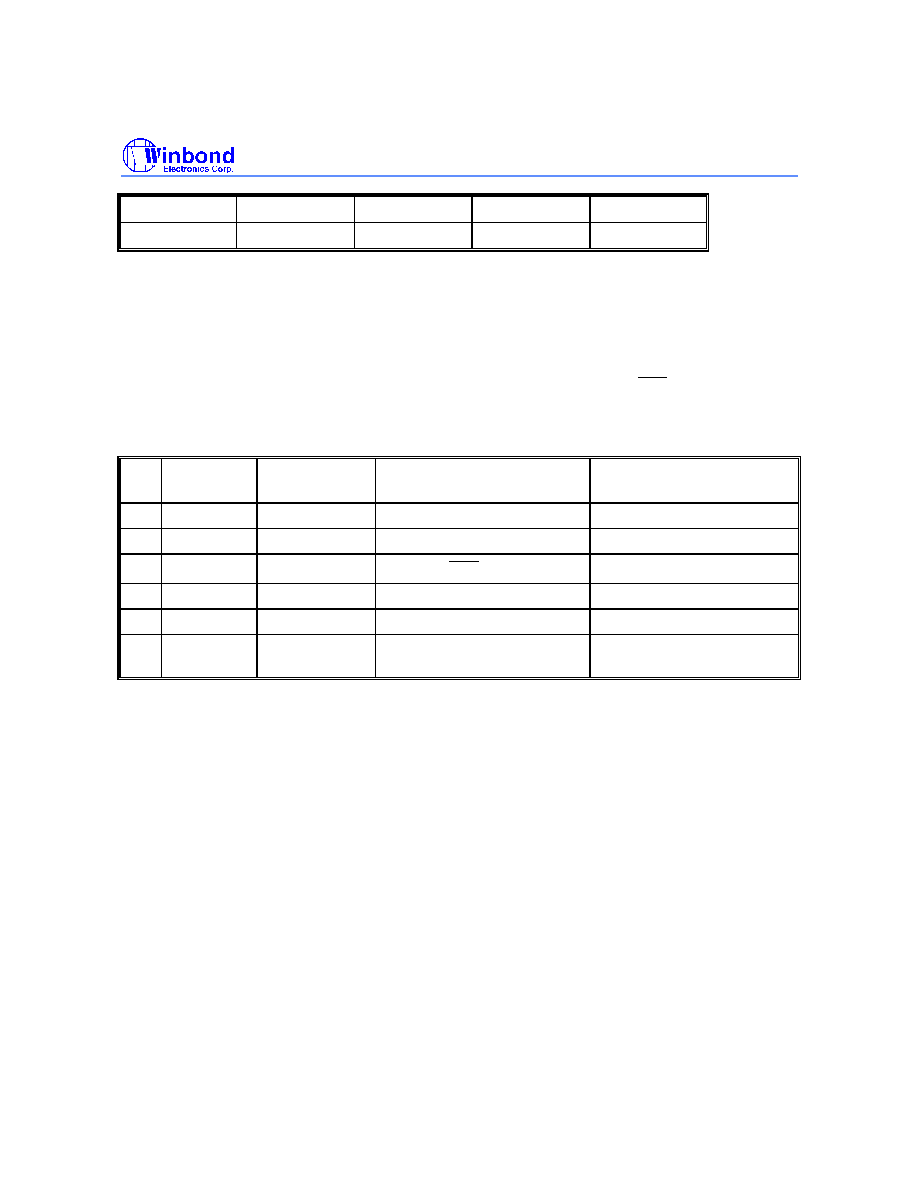
W78E354
- 22 -
16 MHz
18.432 MHz
20 MHz
24 MHz
DSCL Low
750 nS
651 nS
600 nS
499 nS
F. I
2
C Port: Serial Port 2
(S/W emulation).
G. Interrupts
The W78E354 has 6 interrupt sources. Five of them, with the exception of
INT1
(at vector address
0013H) are identical to those of the 8051 series. The remaining one (at vector address 002BH) is a
new addition. All the interrupt sources and the corresponding interrupt vector addresses for the
W78E354 are given in the following table:
SOURCE
VECTOR
DDRESS
DESCRIPTION
PRIORITY WITHIN A LEVEL
1
IE0
0003H
Same as the 8051.
Highest
2
TF0
000BH
Same as the 8051.
3
*1
0013H
Replaces
INT1
of the 8051.
4
TF1
001BH
Same as the 8051.
5
RI+TI
0023H
Same as the 8051.
6
*2
002BH
New addition.
(like TF2 + EXF2 in the 8052)
Lowest
Notes:
*1 = DSCLINT + ADCINT + TIMEOUT + SOAINT + VEVENT + PARAINT + DDC1INT.
*2 is the interrupt generated by the I2C in the DDC port.
The interrupt at vector address 0013H is driven by another seven different sources. These are 1) a
High-to-low transition of the DSCL-pin, 2) the A/D converter, 3) the Auto-reload Timer, 4) the SOA
output, 5) Vsync, 6) the Parabola interrupt generator, and 7) DDC1 in the DDC port. The programmer
must read the INTVECT register to identify the interrupt request source. These seven sources can be
masked individually by setting the corresponding bit within the INTMSK register (Bit0..6). The newly
added interrupt at vector address 002BH is driven by the I2C circuit in the DDC port.
The interrupt enable control bits for the two interrupts at 0013H and 002BH are the bits IE.2 and IE.5
in the IE register, respectively. They can be disabled by clearing IE.7 (disable all interrupts). The
interrupt priority control bits are IP.2 and IP.5 in the IP register, respectively.
The following diagram illustrates the above description.

W78E354
Publication Release Date: April 1997
- 23 -
Revision A1
I C in DDC port
2
OR
TIMEOUT source
DSCLINT source
ADCINT source
PARAINT source
VEVENT source
DDC1INT source
IE0
TF0
TF1
RI+TI
INTMSK
IE
0013H
001BH
0023H
002BH
000BH
0003H
IE.3
IE.4
IE.5
IE.2
IE.1
IE.0
IE.7
IP
IP.0
IP.1
IP.2
IP.3
IP.4
IP.5
Vector Address
High Priority
Low Priority
Interrupt Polling
Sequence
SOAINT source
TIMEOUT
DSCLINT
ADCINT
PARAINT
VEVENT
DDC1INT
SOAINT
INTVECT
Bit 0
Bit 1
Bit 2
Bit 4
Bit 3
Bit 6
Bit 5
H. 8-bit Auto-reload Timer for Software Time Base
This is an 8-bit auto-reload timer, which generates a periodic interrupt to the CPU.
The time interval is programmable:
The minimun interval (unit) = 1/ (F
clock
˜
1024),
the programmable interval = the minimun interval
◊
(AUTOLOAD Reg. value +1),
the maximum interval = the minimun interval
◊
255.
16 MHz
18.432 MHz
20 MHz
24 MHz
Minimum Interval
64
µ
S
55
µ
S
51.2
µ
S
42.6
µ
S
Maximum Interval
16.3 mS
14.2 mS
13.1 mS
10.9 mS
I. Parabola interrupt generator
This is an 16-bit auto-reload timer, which generates a periodic interrupt to the CPU. The interrupt
period is programmable: the time base = 1/Fclock, the programmable interrupt period = the time base
◊
([PARAH, PARAL] 16-bit Reg. value+1), the maximum period = the time base
◊
65535.
J. 6-bit ADC
One 6-bit Analog-to-Digital Converter.
SPEC.:
∑
±
1 LSB

W78E354
- 24 -
∑
Conversion time: <150
◊
12/Fosc sec.
∑
4 channels selected by an analog multiplexer
(ADCS1, ADCS0)
(0, 0)
(0, 1)
(1, 0)
(1, 1)
Selected Channel
ADC0
ADC1
ADC2
ADC3
Set bits ADCS1 and ADCS2 in CONTREG1 to select one of the four analog input channels. The ADC
conversion is started by setting bit ADCSTRT in CONTREG1 using software. When the conversion is
comple, the ADCSTRT bit is cleared by hardware to stop the ADC operation. The ADCINT bit in
INTVECT is set by hardware at the same time.
K. PWM DACs
There are two/fourteen 12/8-bit PWM SDACs and one/three 12/8-bit PWM DDACs in this chip. All
the DAC output buffers have slew rate control to prevent the slew rate from being too large.
Additionally, their outputs are delay-controlled and divided into three groups with different delay times
as follows:
1. Delay about 5ns: BSDAC1, SDAC2, 5, 8, 11, DDAC1.
2. Delay about 10ns: SDAC0, 3, 6, 9, 12, DDAC2.
3. No delay: for the others.
Functional Descriptions:
a. 14 channels of 8-bit Static DAC
The Static DACs are used to generate DC voltages (0
-
5V). There are 14 registers each
corresponding to one 8-bit PWM 14 channel outputs. Unused PWM channels can be used as a
standard output pin, as these pins can supply 0V or 5V.
∑
The duty cycle of the PWM output = Register value
˜
255
∑
The DC voltage after the low pass filter = V
CC
◊
duty cycle
REG. VALUE
DUTY CYCLE
DC VOLTAGE
0
0/255
0V
1
1/255
1/255
◊
5V
n
n/255
n/255
◊
5V
255
255/255
+5V
∑
The PWM frequency FPWM = Fclock
˜
255
16 MHz
18.432 MHz
20 MHz
24 MHz
F
PWM
62.745 KHz
72.282 KHz
78.431 KHz
94.117 KHz
T
PWM
15.94
µ
S
13.83
µ
S
12.75
µ
S
10.62
µ
S

W78E354
Publication Release Date: April 1997
- 25 -
Revision A1
SDAC application circuit:
8/12bit resolution
SDAC
low pass filter
Output
R
C
D1616
T = RC
Voutput = V
CC
◊
n/255, if T >> T
PWM
b. 2 channels of 12-bit Static DAC
The two channel, 12-bit PWM outputs are composed of an 8-bit PWM and a 4-bit BRM (Bit Rate
Multiplier). The 4-bit BRM Reg. value decides which one is to be added one clock preiod in every 16
PWM outputs.
BRM Reg. 4-bit data One clock period is incremented in the n-th output in every 16 PWM outputs.
0000
None
0001
n = 8
0010
n = 4, 12
0100
n = 2, 6, 10, 14
1000
n = 1, 3, 5, 7, 9, 11, 13, 15
Note: See the positions marked with an "*" in the following figure.
BRM
BRM Cycle
Reg. value 0 1 2 3 4 5 6 7 8 9 10 11 12 13 14 15
0001
-
-
-
-
-
-
-
-
*
-
-
-
-
-
-
-
0010
-
-
-
-
*
-
-
-
-
-
-
-
*
-
-
-
0100
-
-
*
-
-
-
*
-
-
-
*
-
-
-
*
-
1000
-
*
-
*
-
*
-
*
-
*
-
*
-
*
-
*
Example:
0000
-
-
-
-
-
-
-
-
-
-
-
-
-
-
-
-
0011
-
-
-
-
*
-
-
-
*
-
-
-
*
-
-
-
1111
-
*
*
*
*
*
*
*
*
*
*
*
*
*
*
*
The 12-bit PWM frequency is the same as that of the 8-bit PWM output.
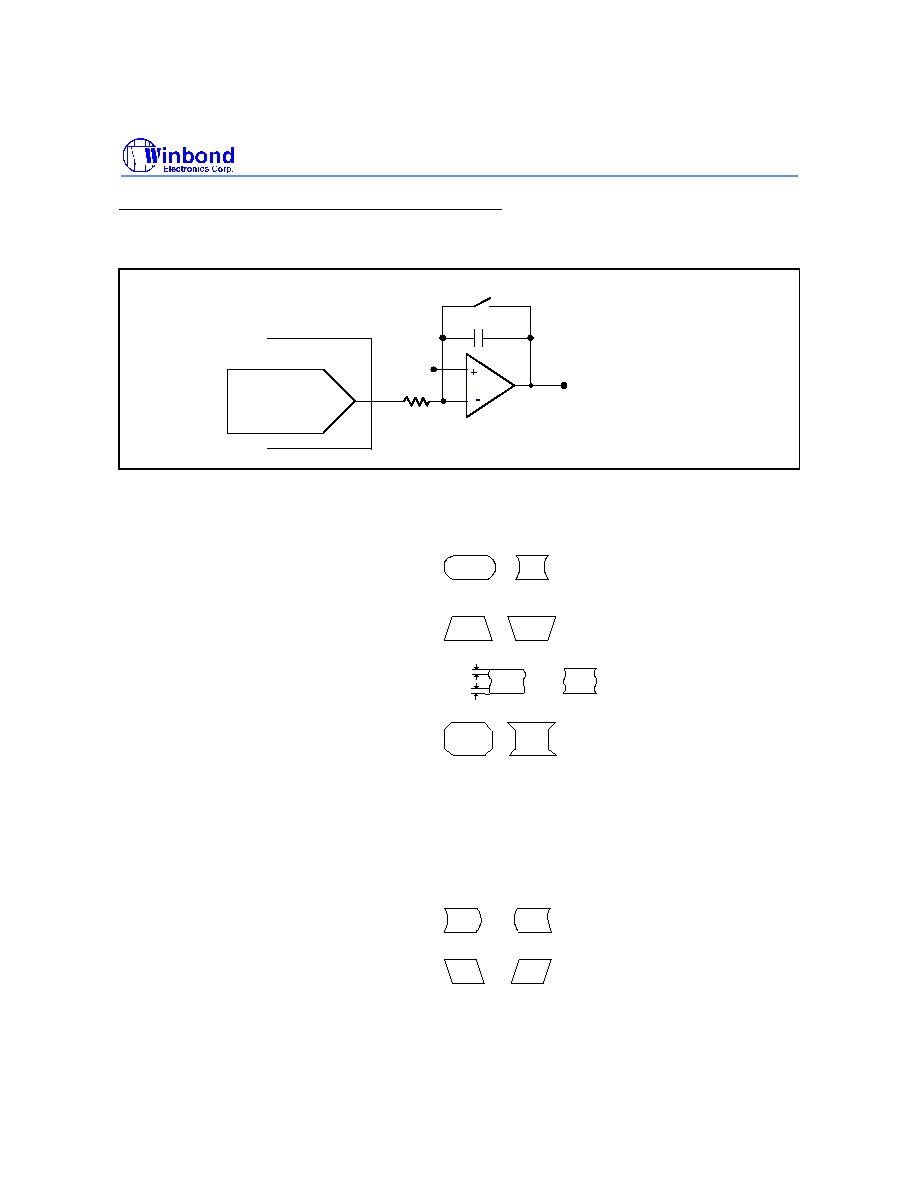
W78E354
- 26 -
c. 1 channel of 12-bit & 3 channels of 8-bit Dynamic DAC
The Dynamic DACs are used to generate a parabola waveform for geometric compensation.
DDAC application circuit:
D1616
2.5V
Balanced/Unbalanced
Parabola
8/12 bit resolution
DDAC
Geometry compensation parabola waveform:
DDAC0
can be used to compensate H size distortion:
1. PinCushion Correction (amplitude)
(PCC amplitude)
2. Trapezoid (Keystone)
3. CBOW (S-comp)
25%
25%
4. PinCushion correction (corner)
(PCC corner)
The PCC amplitude can be compensated against V size adjustment automatically.
The Trapezoid can be compensated against V center adjustment automatically.
DDAC1
is used to compensate H center distortion:
1. Pin balance (Bow)
2. Key balance (Tilt)
Note: The unused dynamic DACs can be used as static DACs.
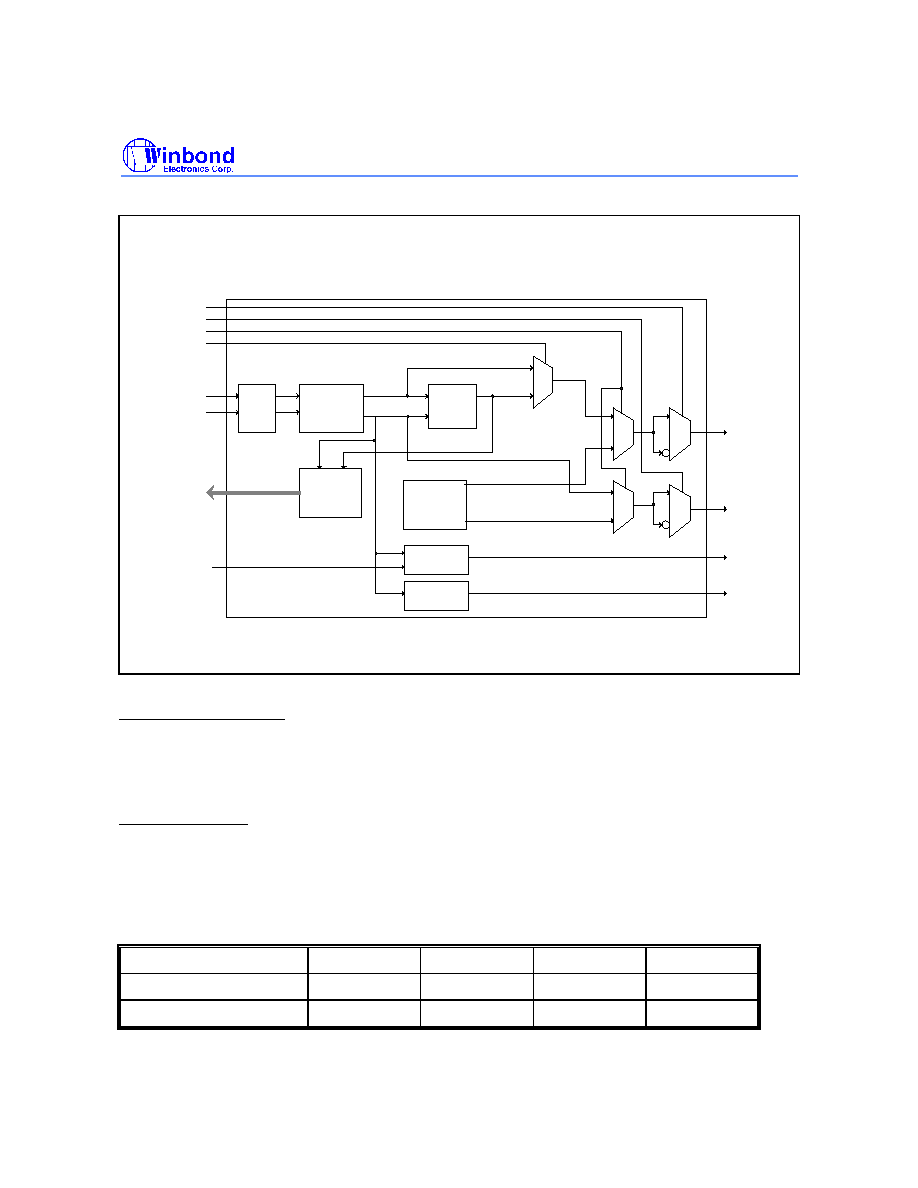
W78E354
Publication Release Date: April 1997
- 27 -
Revision A1
L. Sync Processor
Sync Processor Block Diagram
H
V
Digital
Filter
ENVS
AD[7:0 ]
H-Clamp
Generator
SOA
Generator
VSPS
HSPS
DUMMYEN
1
0
0
0
0
0
1
1
1
1
VDISHC
H/V Dummy
Sync
Generator
HDUMMY
VDUMMY
VSEP
VREST
HREST
H
SOA
H-Clamp
V
H/V
Frequency
Counter
Vsync
Separator
Polarity
Detect &
Restoration
IN
IN
OUT
OUT
a. H/V Sync Digital Filter
Both Hsync and Vsync inputs have an internal digital filter to improve noise immunity. Any pulse that
is shorter than an internal clock period will be regarded as a glitch and will be ignored.
Ex: Tclock = 62 nS @16 MHz, any sync with pulse width less than 62 nS will be regarded as a glitch.
b. Polarity Detector
The H/V polarity is detected automatically and can be read from the STATUS register, the H/V input
signals are then polarity restored (become HREST/VREST) for internal processing and output to
H
OUT
/V
OUT
to drive the deflection circuit.
The maximun sync width to H
IN
pin is: (1/Fclock )
◊
16384
The maximun sync width to V
IN
pin is: (1/Fclock )
◊
16384
F
CLOCK
16 MHz
18.432 MHz
20 MHz
24 MHz
Max. sync width for H
IN
1024
µ
S
888
µ
S
819
µ
S
681
µ
S
Max. sync width for V
IN
1024
µ
S
888
µ
S
819
µ
S
681
µ
S

W78E354
- 28 -
c. Sync Separator
H
V
V
H
To deflection circuit
Vsync
Hsync/
Composite Sync
OUT
OUT
IN
IN
H
V
H (H+V)
V
V
V
Tdelay
Wvmin
Vsync Separator Output (VOUT = VSEP when DUMMYEN = 0, ENVS = 1):
IN
IN
OUT
IN
IN
OUT
The Vsync is separated from the composite sync automatically, without any software effort.
The limitation for the Vsync signal is:
the V
IN
pulse width must be larger than Wvmin = (1/Fclock)
◊
128.5, +/- 1/Fclock
˜
2
V
OUT
is also delayed from the V
IN
signal by Tdelay = (1/Fclock)
◊
128.5, +/- 1/Fclock
˜
2
(if ENVS bit is set to 1)
F
CLOCK
16 MHz
18.432 MHz
20 MHz
24 MHz
1/F
clock
62.5 nS
54 nS
50 nS
41 nS
Min. Vsync Width (Wvmin)
8031 +/- 31 nS 6939 +/- 27 nS 6425 +/- 25 nS
5268 +/- 20 nS
V
OUT
Delay from V
IN
(Tdelay)
8031 +/- 31 nS 6939 +/- 27 nS 6425 +/- 25 nS
5268 +/- 20 nS
d. Horizontal & Vertical Frequency Counter
There are two 16-bit counters which can count H and V frequency automatically. When a VEVENT (V
frequency counter timeout) interrupt occurs, the MCU may read the count value (Hcount and Vcount)
from the counter registers (HFCOUNTH, HFCOUNTL, VFCOUNTH and VFCOUNTL) to calculate the
H and V frequency by the formulas listed below.

W78E354
Publication Release Date: April 1997
- 29 -
Revision A1
V frequency:
The resolution of V frequency counter: Vresol = (1/Fclock )
◊
16.
The V frequency: Vfreq = 1/(Vcount
◊
Vresol ).
The lowest V frequency can be detected: Fclock
˜
1048576.
H frequency:
The resolution of H frequency counter: Hresol = (1/Fclock )
˜
8.
The H frequency: Hfreq = 1/(Hcount
◊
Hresol ).
The lowest H frequency can be detected: Fclock
˜
8192.
16 MHz
18.432 MHz
20 MHz
24 MHz
Vresol
1
µ
s
868 nS
800 nS
666 nS
The Lowest Vfreq
15 Hz
17.6 Hz
19 Hz
23 Hz
Hresol
7.8 nS
6.8 nS
6.3 nS
5.2 nS
The Lowest Hfreq
1.9 KHz
2.3 KHz
2.4 KHz
2.9 KHz
e. Dummy Frequency Generator
The Dummy H and V frequencies are generated for 1) factory burn-in and 2) displaying warning
messages if there is no input frequency.
There are two registers in the dummy sync generator:
DHREG: 4-bit register, determines the Dummy Hsync output frequency
DVREG: 8-bit register, determines the Dummy Vsync output frequency
Dummy Hsync frequency F
dH
= Fclock
˜
32
˜
(DHREG+1)
Dummy Vsync frequency F
dV
= F
dH
˜
8
˜
(DVREG+1)
DUMMYEN
H
OUT
V
OUT
0
HREST
VREST (if ENVS = 0), VSEP (if ENVS = 1)
1
HDUMMY
VDUMMY
Ex. If System clock = 16 MHz
DHREG
F
dH
DVREG
F
dV
15
31.25K
48
79.7 Hz
12
38.5K
59
80.2 Hz
10
45.5K
70
80.1 Hz
9
50K
77
80.1 Hz
7
62.5K
96
80.5 Hz
6
71K
109
80.7 Hz
5
82K
127
80.1 Hz
4
100K
155
80.1 Hz
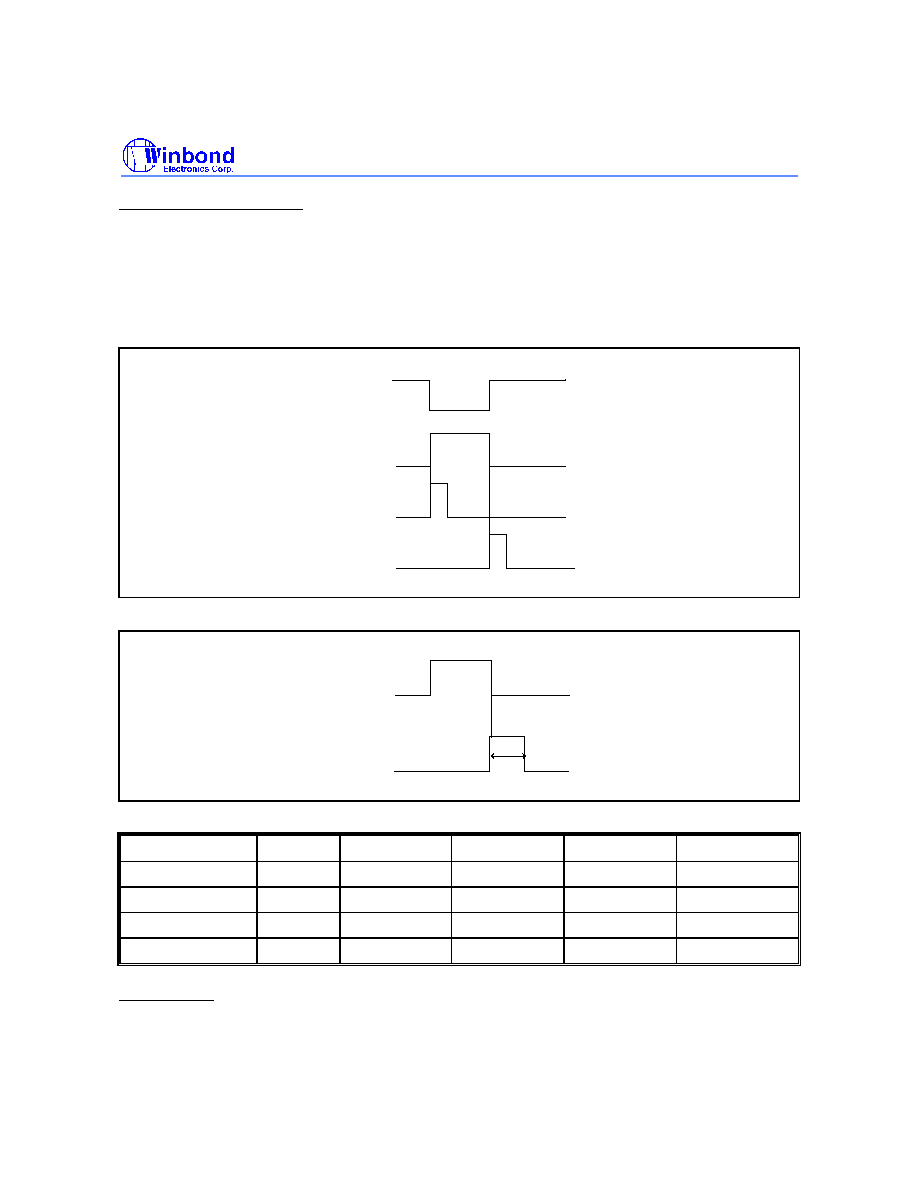
W78E354
- 30 -
f. H-clamp Pulse Generator
If P14SF = 0, P1.4 is a general purpose I/O port.
If P14SF = 1, P1.4 is the H-clamp pulse output.
1. Leading edge / Trailing edge selectable
HCES = 0: select leading edge
HCES = 1: select trailing edge
Hrest
Leading
Edge
Trailing
Edge
Hsync
2. Pulse width selectable
Hsync
H-clamp
ouput
The pulse width is programmable: (1/Fclock)
◊
Option, +/- 1/Fclock
˜
2
(HCWS1, HCWS0)
OPTION
16 MHz
18.432 MHz
20 MHz
24 MHz
(0, 0)
4.5
281 +/- 31 nS
244 +/- 27 nS
225 +/- 25 nS
187 +/- 20 nS
(0, 1)
8.5
531 +/- 31 nS
461 +/- 27 nS
425 +/- 25 nS
353 +/- 20 nS
(1, 0)
16.5
1031 +/- 31 nS
896 +/- 27 nS
825 +/- 25 nS
686 +/- 20 nS
(1, 1)
32.5
2031 +/- 31 nS 1764 +/- 27 nS 1625 +/- 25 nS
1352 +/- 20 nS
g. SOA output
If P15SF = 0, P1.5 is a general purpose I/O port.
If P15SF = 1, P1.5 is the SOA output.
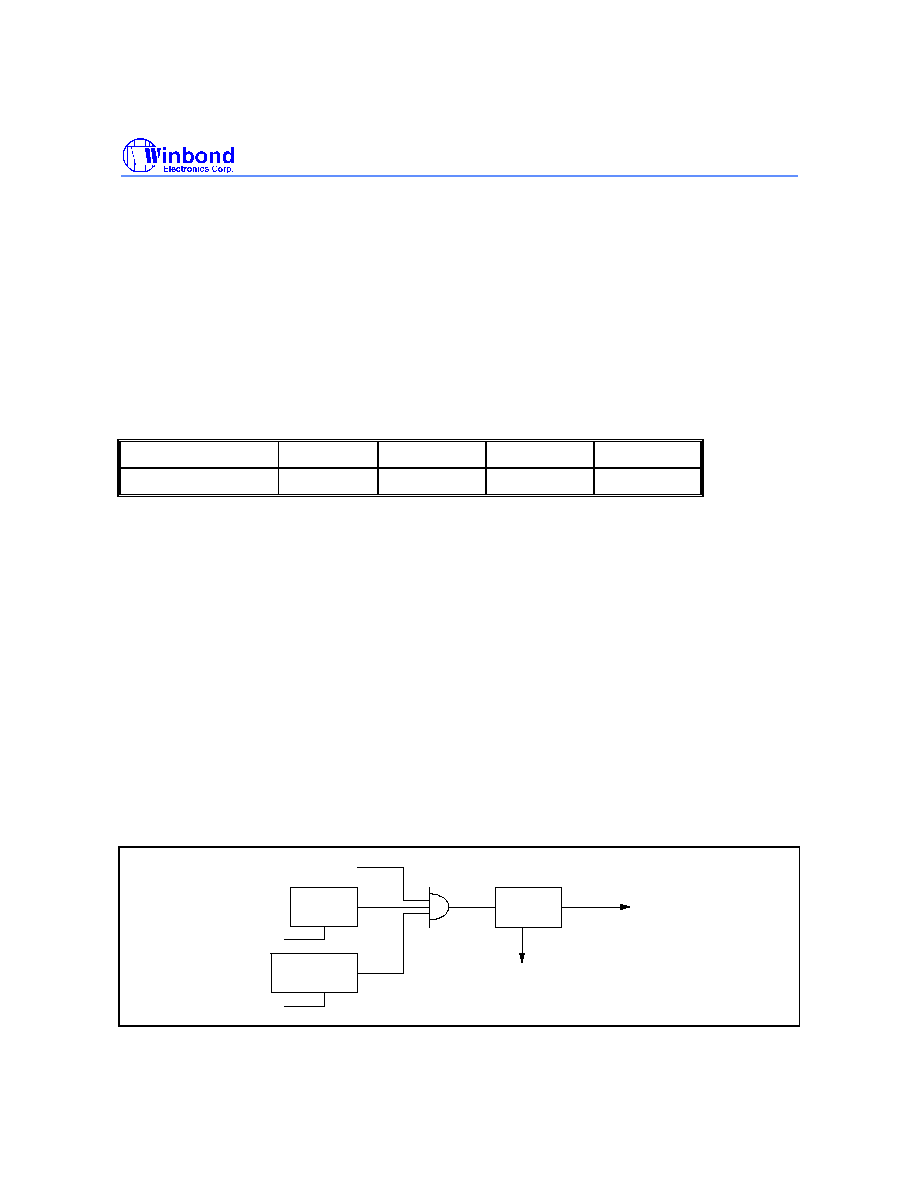
W78E354
Publication Release Date: April 1997
- 31 -
Revision A1
Purpose:
To protect the HOT (Horizontal Oscillating Transistor) and other critical circuitry by making a quick
response when the Hsync frequency drops below the preset boundary frequency.
Operation:
When the Hsync frequency is lower than the boundary frequency for three consecutive cycles or
stopped for a certain period, the SOA pin (P1.5) will change to a "high" state (for the extenal
protection circuit to function). Writing any value to the SOACLR register will release the SOA pin.
To set the boundary frequency, one can write some formula:value to the SOAREG register according
to the SOAREG value = 2M
˜
boundary frequency
Ex: If 50 KHz is considered the boundary frequency, then SOAREG = 2M
˜
50K = 40.
No Hsync response time = 2048
◊
(1/F
clock
).
16 MHz
18.432 MHz
20 MHz
24 MHz
No H response time
128
µ
S
110
µ
S
102
µ
S
85
µ
S
M. Power Supervisor, Watchdog Timer and Reset Circuitry
The reset signals come from the following three sources:
1. External reset input (active low)
2. Power low detect
3. Hardware Watchdog Timer
The power-low detection circuit generates a reset signal once the V
CC
voltage falls below 3.8V. This
reset signal is released a short time after V
CC
has increased above 4.3V. This function can be
enabled or disabled by a code option.
The purpose of a watchdog timer is to reset the CPU if it enters erroneous processor states (possibly
caused by electrical noise or RFI) within a reasonable period of time. The watchdog timer clock
source comes from the internal system clock and can be enabled or disabled by a code option. When
enabled, the watchdog circuitry will generate a system reset if the user program fails to reload the
watchdog timer (by writing any value to the WDTCLR register) within a specified length of time known
as the "watchdog interval". The watchdog interval has four code options: 219/fosc, 221/fosc, 223/fosc
and 224/fosc sec.
The block diagram of the reset circuitry is shown as follows:
Watchdog
Timer
Power-low
Detect Circuit
EnWDT_Bit
EnSVS_Bit
EN
EN
External Reset
CPU
POR
Reset the other
function blocks
XRESET
Reset all DACs

W78E354
- 32 -
FLASH CELL DESCRIPTION
A. Flash ROM Interface
The following diagram shows the Flash cell block control interface. A<0:14> are the address bus
inputs and Dout<0:7> are the data bus outputs of the Flash ROM.
Flash ROM (16KB)
VPP VDD
VSS
0
1
s
0
1
s
0
1
s
0
1
s
0
1
s
0
1
s
0
1
s
OSCEN
(normally "0")
/CE
(PAD)
/CE
/OE
(PAD)
/OE
A13CTRL
(PAD)
A9CTRL
(PAD)
A9HV
A13HV
A14CTRL
(PAD)
A14HV
A<0:14>
(PAD)
Select signal will be decided by
/RESET, /PROG, A9CTRL, A13CTRL, A14CTRL and OECTRL.
Din<0:7>
A<0:14>
Dout<0:7>
8
MUX
D<0:7>
(PAD)
8
8
15
PC
15
15
* A14 = 0 at normal operation all the time.
8
8
OPTION<0:7>
ROM-MAP<0:7>
8
8
OECTRL
(PAD)
OECTRL
0
1
s
Flash ROM Block Diagram

W78E354
Publication Release Date: April 1997
- 33 -
Revision A1
V
PP
is the high voltage input while in Flash Mode.
A<0:14>
is the address bus of the Flash cell while
in Flash Mode.
Dout<0:7>
is the data bus output of the Flash cell and
Din<0:7>
is the data bus input
while the chip is in Flash mode. The
A9CTRL, A13CTRL,
A14CTRL
and
OECTRL
signals are used
to select the Flash Mode. The
OE
and
CE
signals are the control strobe signals for Flash Mode
operation. These signals are operational only in Flash Mode and appear as inputs/outputs via the
external pins with a "Test Name" as listed in the Pin Description in Sec. D.
During normal operation, the critical timing parameter is the Flash data access time. When operating
at 24 MHz, the Flash cell requires 150 nS after an address out until the data is valid, as shown below.
Timing for Flash ROM Data Access
0000
0001
0002
ROM
Address
A<0:14>
ROM
Data
Dout<0:7>
#AAH
Sample
Clock
Max. 150 nS for 24 MHz
B. Option Setting Bits
The
Option setting bits
are used to set user-selectable options. These bits are programmed in the
same way as the 16K byte Flash ROM except for the address A<14:0> which is 7FFFH.
MSB
LSB
B4
B3
B2
B1
Note: Default value is 1 for each bit.
∑
B1: EnWDT_Bit. (1: Disable, 0:Enable)
This bit is used to enable/disable the Watchdog Timer operation.
∑
(B3, B2): WatchDog Timer period set.
These two bits are used to set the time period of the Watchdog timer.
(0, 0): 219/fosc sec.
(0, 1): 221/fosc sec.
(1, 0): 223/fosc sec.
(1, 1): 224/fosc sec.
Where fosc is the crystal frequency.
∑
B4: EnSVS_Bit. (1: Disable, 0:Enable)
This bit is used to enable/disable the Power-low-detection function.

W78E354
- 34 -
C. ROM-MAP Bits
In order to increase the functionality of the 16K byte Flash ROM, the Flash ROM is divided into 4
blocks. If some blocks contain bad Flash cells but the other blocks are good, the 16KB Flash can be
treated as either 8KB or 4KB, and the W78E354 downgraded to either the W78E352 or the
W78E351.
Four ROM-MAP bits are used to indicate the availability of the 16K bytes of Flash ROM after testing.
MSB
LSB
ROM-MAP
B3
B2
B1
B0
16K bytes Flash ROM
Set B0 = 1 if block 0 is available.
Block 0, 4K bytes
Set B1 = 1 if block 1 is available.
Block 1, 4K bytes
Set B2 = 1 if block 2 is available.
Block 2, 4K bytes
Set B3 = 1 if block 3 is available.
Block 3, 4K bytes
Note: Only one/two/four of the four bits can be set to indicate whether 4K/8K/16K are usable.
FLASH/TEST MODE
A. Flash Modes
1. Read
This mode is supported for customer code verification. The data will be invalid if the Lock bit is set
low.
2. Output Disable
When the
OE
is set high, no data outputs appear on D7..D0.
3. Standby
This condition disables the DC path from the Flash cell to reduce power consumption.
4. Program
This mode is used to program the Flash cell and option bits. It is the only way to change data from "1"
to "0".
5. Program Verify
All the programming data must be checked after program or mass program operations. This operation
should be performed after each byte is programmed to ensure a substantial program margin.
6. Erase
An erase operation is the only way to change data from "0" to "1".
7. Erase Verify
After an erase operation, all of the bytes in the chip must be verified to check whether they have been
successfully erased to 1 or not. The erase verify operation automatically ensures a substantial erase
margin. This operation will be implemented after the erase operation if V
PP
= V
EP
(14.5V),
CE
is high
and
OE
is low.

W78E354
Publication Release Date: April 1997
- 35 -
Revision A1
8. Proram/Erase Inhibit
This operation allows parallel erasing or programming of multiple chips with different data.
9. Mass Program
In order to increase the throughput of testing, this operation programs 256 bytes with the same data
simultaneously. Note that 256 program verify operations must follow each mass program operation.
All the timings for this operation are the same as those of the byte program operation except that the
/CE program pulse width is 125
µ
S. In addition, this operation is also used for cell reliability analysis
by stressing the source line.
10. Read Company ID and Device ID
These two modes are especially useful in EPROM WRITERs, which can read the silicon identification
to set the appropriate erase or program algorithm to match the device being erased or programmed.
11. VT
This operation is used for cell performance analysis. By connecting 2V to the D7..D0 pins, the cell
currents can be measured for each location within the chip by specifying its appropriate address.
12. Read ROM-map Bits
This operation is used to verify the ROM-MAP bits which were programmed previously. Its action is
the same as an EEPROM read operation.
13. Fuse ROM-map Bits
The ROM-MAP bits can be fused by this operation only. Its action is the same as an EEPROM
program operation.
14. Erase ROM-map Bits
The ROM-MAP bits can be erased by this operation only. Its action is the same as an EEPROM erase
operation.
15. CKBD & /CKBD Mass Program
These two operations are used to mass program the Flash cells in such a way that the state of any bit
is different from those of its neighboring bits.
16. Read Disturb
B. Test Mode
*RAM-test Mode
This mode is used to verify the function of the internal 512 bytes of RAM by a write-in and then read-
out operation.
*Functional Test Mode
If the
EA
(TestCLK) pin is pulled low when the chip is being reset and remains low for at least 24
clock periods after the reset, the CPU will execute from the external program memory (maximum
program size is 2K bytes). This feature may be used to test the chip's functions via an external
program. It should be noted that this mode is like the normal operation except that the CPU executes
from external program memory and that some different pins are used in place of A10
-
A0, D7
-
D0 and
PSEN
instead of their original functions.

W78E354
- 36 -
Flash/RAM-test Mode Configuration Table.
CONFIGURATION
Flash Modes
A9CTRL A13CTRL A14CTRL OECTRL /CE /OE
V
PP
A14..A0
D7..D0
Read
0
0
0
0
0
0
1
Address
Data Out
Output Disable
0
0
0
0
0
1
1
X
High-Z
Standby
0
0
0
0
1
X
1
X
High-Z
Program
0
0
0
0
0
1
V
CP
Address
Data In
Program Verify
0
0
0
0
1
0
V
CP
Address
Data Out
Erase [*3]
1
0
0
0
0
1
V
EP
A0 = 0, others: X
Data In (FFh)
Erase Verify
1
0
0
0
1
0
V
EP
Address
Data Out
Program/Erase
Inhibit
0
0
0
0
1
1
V
CP
/V
EP
X
X
Mass Program
0
0
1
0
0
1
V
CP
X
Data In
Read Company ID
Read Device ID
1
0
0
0
0
0
1
A0 = 0, others: X
A0 = 1, others: X
Data Out (DAh)
Data Out (64h)
VT
0
0
0
1
0
1
1
Address
Cell Current
Read ROM-MAP
0
1
0
0
0
0
1
7FFFh
Data Out
Fuse ROM-MAP
0
1
0
0
0
1
V
CP
7FFFh
Data In
Erase ROM-MAP
1
1
0
0
0
1
V
EP
X
Data In (FFh)
CKBD & /CKBD
Mass Program
1
0
1
0
0
1
V
CP
A6, A0
[*4]
Data In (00h)
Read Disturb
1
1
1
0
0
0
1
Address
Data Out
CONFIGURATION
RAM-test Modes
A9CTRL A13CTRL A14CTRL OECTRL /CE /OE
V
PP
A14..A9 A8
A7..A0
D7..D0
8032's 256 bytes of
RAM-write
0
1
1
X
0
1
X
X
0
Address
Data In
8032's 256 bytes of
RAM-read
0
1
1
X
1
0
X
X
0
Address
Data Out
Data Memory by
MOVX-write
0
1
1
X
0
1
X
X
1
Address
Data In
Data Memory by
MOVX-read
0
1
1
X
1
0
X
X
1
Address
Data Out
Notes:
1: RESET and PROG must be kept low for all the above modes.
2: "X" means "Don't care" but not floating. V
CP
= 12.5V, V
EP
= 14.5V, "1" stands for V
DD
and "0" for V
SS
.
*3: The Erase operation erases all the 16K bytes of Flash cell but not the ROM-MAP cell.
*4: A0/A6 decides whether the bit-line/word-line is even or odd.
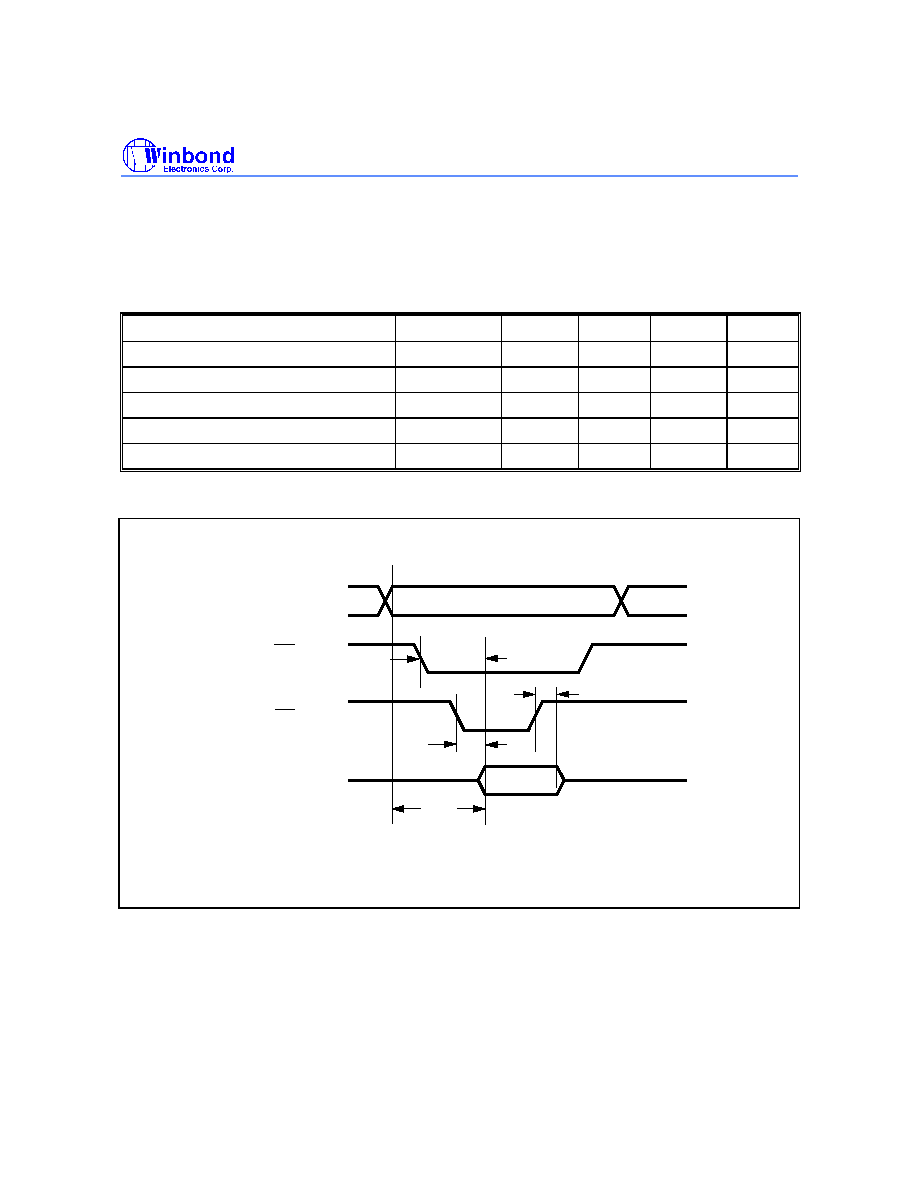
W78E354
Publication Release Date: April 1997
- 37 -
Revision A1
For CKBD, (A6, A0) = (0, 0) and then (1, 1); for /CKBD, (A6, A0) = (1, 0) and then (0, 1).
G.3 Flash Mode Timing Waveforms
*Read Operation
(including EEPROM, Company ID, Device ID, Option bits and ROM-MAP bits Read)
PARAMETER
SYMBOL
MIN.
TYP.
MAX.
UNIT
Address Access Time
T
ACC
-
-
150
nS
Chip Enable Access Time
T
CE
-
-
150
nS
Output Enable Access Time
T
OE
-
-
150
nS
Output Data Hold Time
T
ODH
0
-
-
nS
Output Data Float Time
T
ODF
-
-
100
nS
Read Waveform
(A14..A0)
Valid Address
V
IH
V
IL
CE
V
IH
V
IL
V
IH
V
IL
OE
D7..D0
V
IH
V
IL
Data
T
CE
T
ACC
T
ODH/ODF
T
OE
Note: Please pay attention to the relation between /CE's and /OE's waveforms.

W78E354
- 38 -
*Erase Operation
(including EEPROM&Option bits and ROM-MAP bits Erase)
PARAMETER
SYMBOL
MIN.
TYP.
MAX.
UNIT
Vpp Setup Time
T
VPS
2.0
-
-
µ
S
Address Setup Time
T
AS
2.0
-
-
µ
S
Address Hold Time
T
AH1
2.0
-
-
µ
S
Erase Pulse Width
T
EPW
-
1
5
mS
Output Data Valid after
OE
Low
T
ODV
-
-
150
nS
Address Hold Time
T
AH2
0
-
-
µ
S
Output Data Hold Time
T
ODH
0
-
-
nS
Output Data Float Time
T
ODF
-
-
100
nS
Erase Waveform
A14..A0
A0 = 0
V
IH
V
IL
CE
V
IH
V
IL
V
IH
V
IL
OE
D7..D0
V
IH
V
IL
VPP
D
OUT
Vep
V
IH
Erase
Erase
Verify
Address Stable
T
AS
T
VPS
T
AH1
T
ODV
T
EPW
T
AH2
T
ODH/ODF
T
AS

W78E354
Publication Release Date: April 1997
- 39 -
Revision A1
*Program & Mass Program Operation
(including EEPROM, Option bits and ROM-MAP bits Program, and Mass Program)
PARAMETER
SYMBOL
MIN.
TYP.
MAX.
UNIT
Vpp Setup Time
T
VPS
2.0
-
-
µ
S
Address Setup Time
T
AS
2.0
-
-
µ
S
Input Data Setup Time
T
IDS
2.0
-
-
µ
S
Input Data Hold Time
T
IDH
2.0
-
-
µ
S
Program Pulse Width
T
PPW
-
100
200
µ
S
Mass Program Pulse Width
T
MPPW
-
500
1000
mS
Output Data Valid after
OE
Low
T
ODV
-
-
150
nS
Address Hold Time
T
AH
0
-
-
µ
S
Output Data Hold Time
T
ODH
0
-
-
nS
Output Data Float Time
T
ODF
-
-
100
nS
Program Waveform
A14..A0
V
IH
V
IL
CE
V
IH
V
IL
V
IH
V
IL
OE
D7..D0
V
IH
V
IL
VPP
Vcp
V
IH
Program
Program
Verify
Address Stable
T
AS
T
VPS
T
IDH
T
ODV
T
PPW
T
ODH/ODF
Data In
Data Out
T
IDS
T
AH
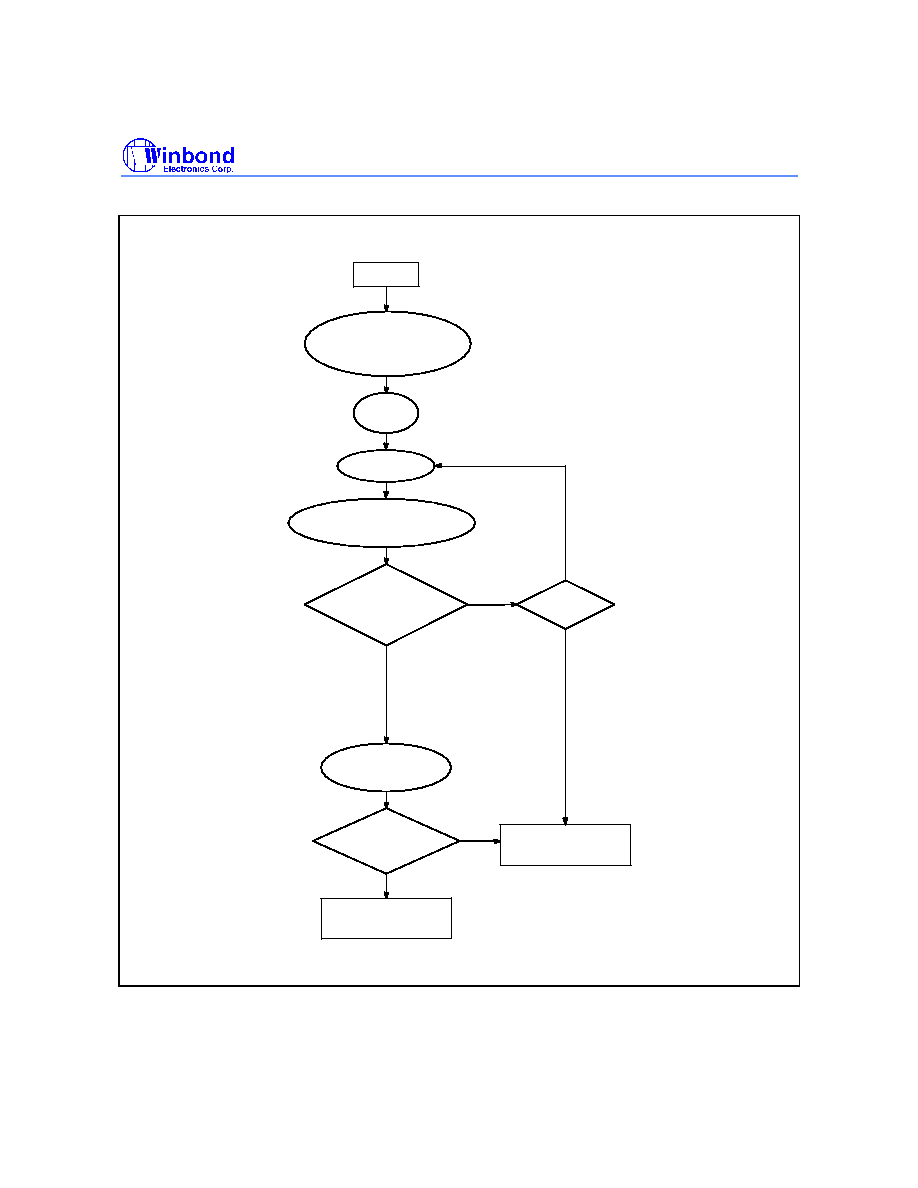
W78E354
- 40 -
D.1 Smart Erase Algorithm
Start
Vpp = 14.5V
Enter ERASE Mode
N = 0
Erase one 1 mS pulse
Increment N
N = 10 ?
Erase Verify
(Verify all bytes,
must be FFh)
Vpp = 5.0V
Enter READ Mode
Read Verify
(Blank check)
NO
YES
PASS
FAIL
Erase Fail !
FAIL
PASS
Erase Pass !
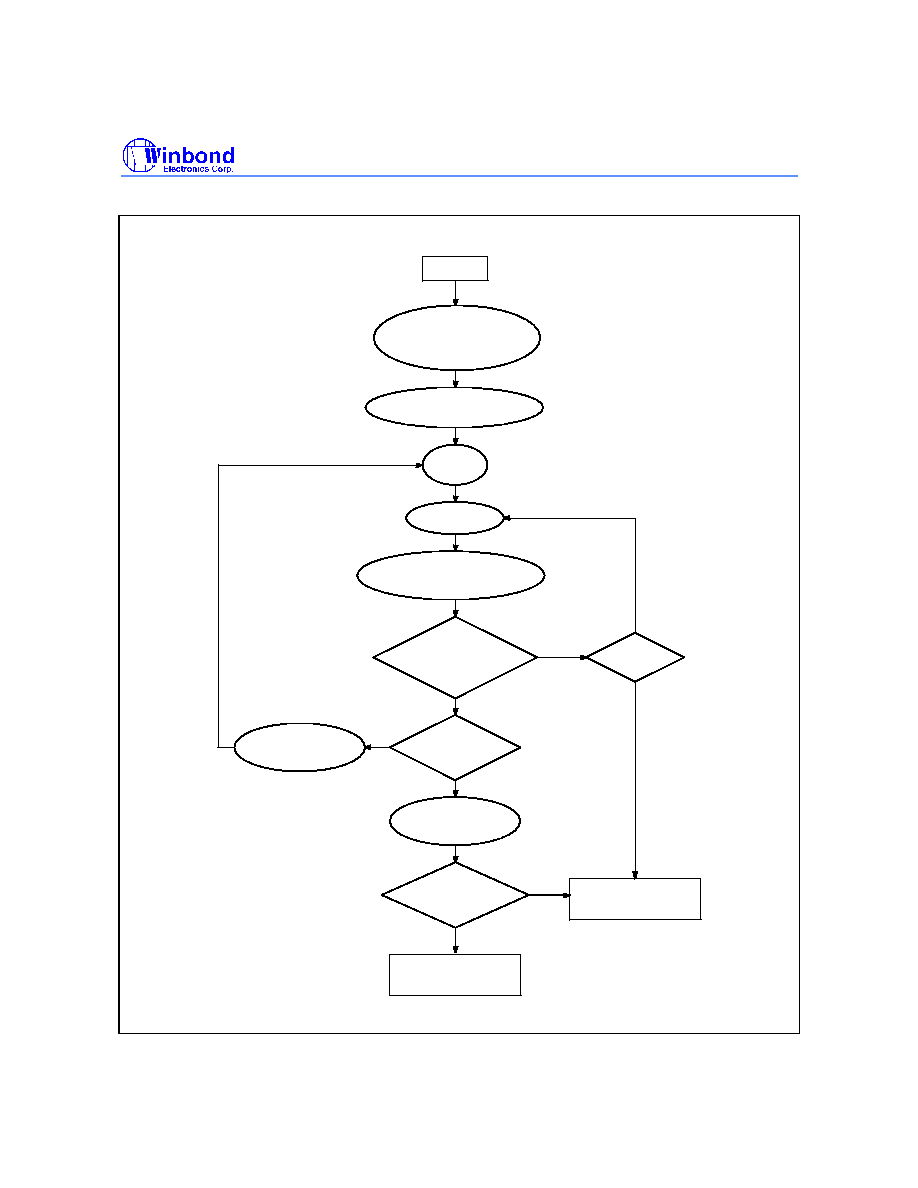
W78E354
Publication Release Date: April 1997
- 41 -
Revision A1
D.2 Smart Program Algorithm
Start
Vpp = 12.5V
Enter PROGRAM Mode
N = 0
Program One 100 uS Pulse
Increment N
N = 10 ?
Program Verify
(Verify one byte)
Last Address ?
Vpp = 5.0V
Enter Rdad Mode
Read Verify
(Verify all bytes)
Increment Address
Address = First Location
NO
YES
PASS
FAIL
Program Fail !
FAIL
PASS
YES
NO
Program Pass !

W78E354
- 42 -
ABSOLUTE MAXIMUM RATINGS
PARAMETER
SYMBOL
MIN.
MAX.
UNIT
DC Power Supply
V
DD
-0.3
+7.0
V
Input Voltage
V
IN
V
SS
-0.3
V
DD
+0.3
V
Input Current
I
I
-100
+100
mA
Operating Temperature
T
A
0
70
∞
C
Storage Temperature
T
ST
-55
150
∞
C
Note: Exposure to conditions beyond those listed under Absolute Maximum Ratings may adversely affect the life and reliability
of the device.
ELECTRICAL CHARACTERISTICS
Normal Operation D.C. Characteristics
(V
DD
& V
AA
)
-
V
SS
= 5V
±
10%, T
A
= 25
∞
C, Fosc = 20 MHz, unless otherwise specified.
PARAMETER
SYM.
SPECIFICATION
UNIT
TEST CONDITIONS
Min.
Typ.
Max.
Operating Voltage
V
DD
4.5
5
5.5
V
Operating Current
I
DD
-
-
65
mA
No load, V
DD
= 5.5V
Idle Current
I
IDLE
-
-
30
mA
No load, V
DD
= 5.5V
Power-down Current
I
PD
-
-
10
µ
A
No load, V
DD
= 5.5V
Inputs
Logic 0 Input Current
P1, P2, P3 (except P1.0
-
P1.3,
P1.5)
I
IN1
-75
-
-10
µ
A
V
DD
= 5.5V
V
IN
= 0V
Input Current
RESET
, TestCLK
(*1)
I
IN2
-250
-
-
µ
A
V
DD
= 5.5V
V
IN
= 0V
Input Current
H
IN
, V
IN
(*2)
I
IN3
-
-
+30
µ
A
V
DD
= 5.5V
V
IN
= V
DD
Input Leakage Current
P1.0
-
P1.3, ADC0
-
ADC3
I
LK
-10
-
+10
µ
A
V
DD
= 5.5V
0V < V
IN
< V
DD
Logical 1-to-0 Transition
Current
P1, P2, P3
(*3)
(except P1.0
-
P1.3, P1.5)
I
TL
-650
-
-
µ
A
V
DD
= 5.5V
V
IN
= 2.0V

W78E354
Publication Release Date: April 1997
- 43 -
Revision A1
Normal Operation D.C. Characteristics, continued
PARAMETER
SYM.
SPECIFICATION
UNIT
TEST CONDITIONS
Min.
Typ.
Max.
Input Low Voltage
(*4)
P1, P2, P3 (except P1.0
-
P1.3,
P1.5)
RESET
V
IL1
0
-
0.8
V
V
DD
= 4.5V
Input Low Voltage
(*4)
H
IN
, V
IN
V
IL2
0
-
0.8
V
V
DD
= 4.5V
Input Low Voltage
(*4)
P1.0
-
P1.3
V
IL3
0
-
1.5
V
V
DD
= 4.5V
Input High Voltage
P1, P2, P3 (except P1.0
-
P1.3,
P1.5)
V
IH1
2.4
-
V
DD
+0.2
V
V
DD
= 5.5V
Input High Voltage
(*4)
RESET
, OSCIN
V
IH2
3.5
-
V
DD
+0.2
V
V
DD
= 5.5V
Input High Voltage
(*4)
H
IN
, V
IN
V
IH3
2.4
-
V
DD
+0.2
V
V
DD
= 5.5V
Input High Voltage
(*4)
P1.0
-
P1.3
V
IH4
3.0
-
V
DD
+0.2
V
V
DD
= 5.5V
Outputs
Output Low Voltage
P1.0, P1.1
V
OL1
-
-
0.4
V
V
DD
= 4.5V
I
OL
= +2 mA
Output Low Voltage
P1.2, P1.3
V
OL2
-
-
0.4
V
V
DD
= 4.5V
I
OL
= +6 mA
Output Low Voltage
P1.4, P1.5, P2.2
-
P2.7
SDAC0
-
13, H
OUT
, V
OUT
V
OL3
-
-
0.45
V
V
DD
= 4.5V
I
OL
= +4 mA
Output Low Voltage
P2.0, P2.1
V
OL4
-
-
0.5
V
V
DD
= 4.5V
I
OL
= +15 mA
Output Low Voltage
P3, P4
V
OL5
-
-
0.45
V
V
DD
= 4.5V
I
OL
= +2 mA
Output Low Voltage
BSDAC0
-
1, DDAC0
-
2, BDDAC
V
OL6
-
-
0.45
V
V
DD
= 4.5V
I
OL
= +8 mA
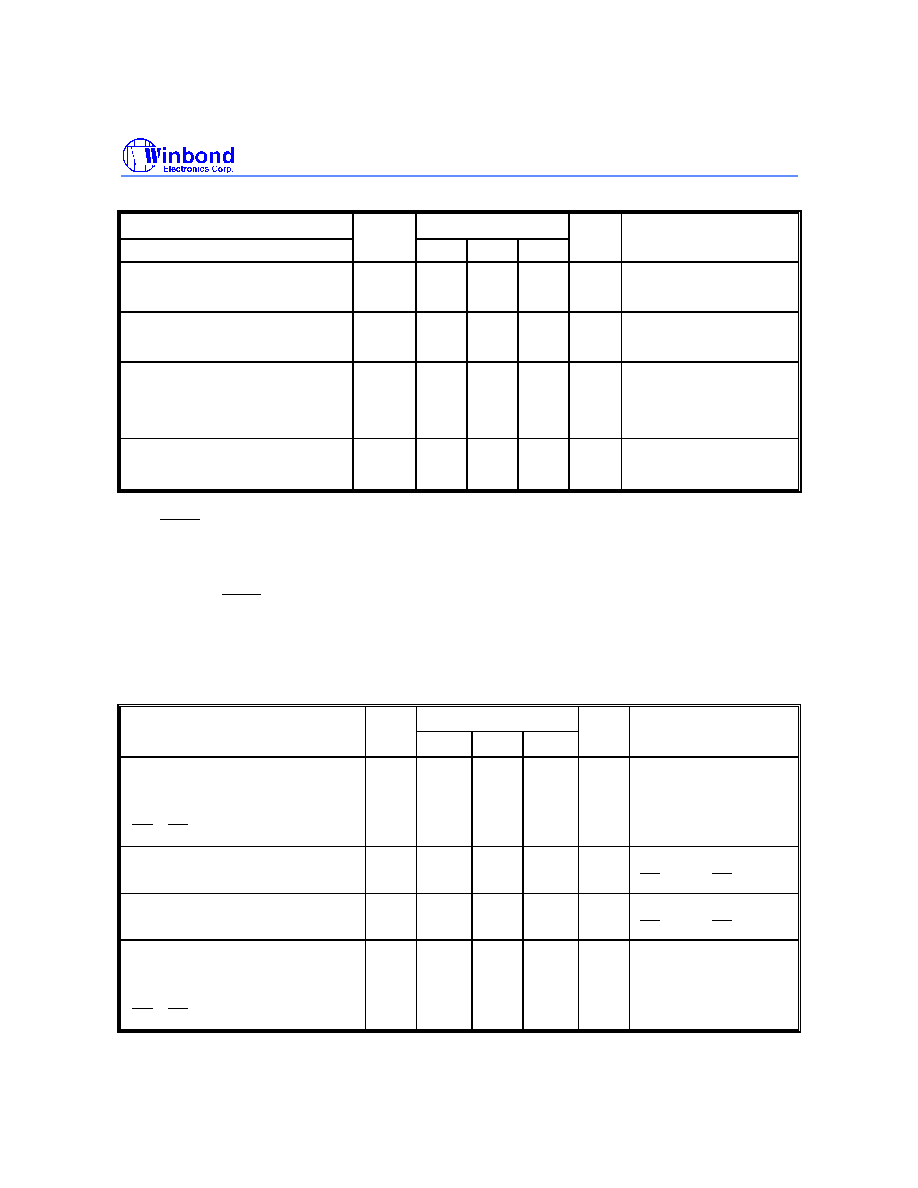
W78E354
- 44 -
Normal Operation D.C. Characteristics, continued
PARAMETER
SYM.
SPECIFICATION
UNIT
TEST CONDITIONS
Min.
Typ.
Max.
Output High Voltage
P1.4, P2, P3
V
OH1
2.4
-
-
V
V
DD
= 4.5V
I
OL
= -100
µ
A
Output High Voltage
P4
V
OH2
2.4
-
-
V
V
DD
= 4.5V
I
OH
= -2 mA
Output High Voltage
P1.5, SDAC0
-
13, H
OUT
, V
OUT
S.F. of P1.4 and P2.3
-
P2.7
(*5)
V
OH3
2.4
-
-
V
V
DD
=4.5V
I
OH
= -4 mA
Output High Voltage
BSDAC0
-
1, DDAC0
-
2, BDDAC
V
OH4
2.4
-
-
V
V
DD
= 4.5V
I
OH
= -8 mA
Notes:
*1. RESET and TestCLK have an internal pull-up resistor of about 30 K
.
*2. H
IN
and V
IN
have an internal pull-down resistor of about 200 K
.
*3. P1, P2 and P3 (except P1.0
-
P1.3 and P1.5) can source a transition current when they are being externally
driven from 1 to 0. The transition current reaches its maximum value when V
IN
is approximately 2V.
*4. P1.0
-
P1.3, RESET , H
IN
and V
IN
are Schmitt trigger inputs, and OSCIN is a CMOS input.
*5. While outputing a special function, the source current of P1.4 and P2.3
-
P2.7 is -4 mA.
Flash Operation D.C. Characteristics
(V
DD
& V
AA
)
-
V
SS
= 5V
±
10%, T
A
= 25
∞
C, Fosc = 20 MHz, unless otherwise specified.
PARAMETER
SYM.
SPECIFICATION
UNIT
TEST CONDITIONS
MIN.
TYP.
MAX.
Input Current
A0
-
A14, D0
-
D7, A9CTRL,
A13CTRL, A14CTRL, OECTRL,
OE
,
CE
I
IN
-75
-
+10
µ
A
V
DD
= 5.5V
V
IN
= 0V or V
DD
V
PP
Erase Current (V
PP
= V
EP
)
I
EP
-
-
+200
µ
A
V
DD
= 5.5V
CE
= V
IL
,
CE
= V
IH
V
PP
Program Current (V
PP
= V
CP
)
I
CP
-
-
+200
µ
A
V
DD
= 5.5V
CE
= V
IL
,
CE
= V
IH
Input Low Voltage
A0
-
A14, D0
-
D7, A9CTRL,
A13CTRL, A14CTRL, OECTRL,
OE
,
CE
V
IL
0
-
0.8
V
V
DD
= 4.5V

W78E354
Publication Release Date: April 1997
- 45 -
Revision A1
Flash Operation D.C. Characteristics, continued
PARAMETER
SYM.
SPECIFICATION
UNIT
TEST CONDITIONS
MIN.
TYP.
MAX.
Input High Voltage
A0
-
A14, D0
-
D7, A9CTRL,
A13CTRL, A14CTRL, OECTRL,
OE
,
CE
V
IH
2.4
-
V
DD
+0.2
V
V
DD
= 5.5V
Output Low Voltage
D0
-
D7
V
OL
-
-
0.45
V
V
DD
= 4.5V
I
OL
= +2 mA
Output High Voltage
D0
-
D7
V
OH
2.4
-
-
V
V
DD
= 4.5V
I
OH
= -100
µ
A
V
PP
Erase Voltage
V
EP
14.25
14.5
14.75
V
V
PP
Program Voltage
V
CP
12.25
12.5
12.75
V
TYPICAL APPLICATION
Please note:
While the chip is being powered on and the
RESET
pin is low, if P1.5 and P3.2 are kept low at the
same time, then the POR (Power-on Reset) will last until P1.5 or P3.2 is pulled High, whichever
occurs first.
Headquarters
No. 4, Creation Rd. III,
Science-Based Industrial Park,
Hsinchu, Taiwan
TEL: 886-3-5770066
FAX: 886-3-5792697
http://www.winbond.com.tw/
Voice & Fax-on-demand: 886-2-27197006
Taipei Office
11F, No. 115, Sec. 3, Min-Sheng East Rd.,
Taipei, Taiwan
TEL: 886-2-27190505
FAX: 886-2-27197502
Winbond Electronics (H.K.) Ltd.
Rm. 803, World Trade Square, Tower II,
123 Hoi Bun Rd., Kwun Tong,
Kowloon, Hong Kong
TEL: 852-27513100
FAX: 852-27552064
Winbond Electronics North America Corp.
Winbond Memory Lab.
Winbond Microelectronics Corp.
Winbond Systems Lab.
2727 N. First Street, San Jose,
CA 95134, U.S.A.
TEL: 408-9436666
FAX: 408-5441798
Note: All data and specifications are subject to change without notice.












































